
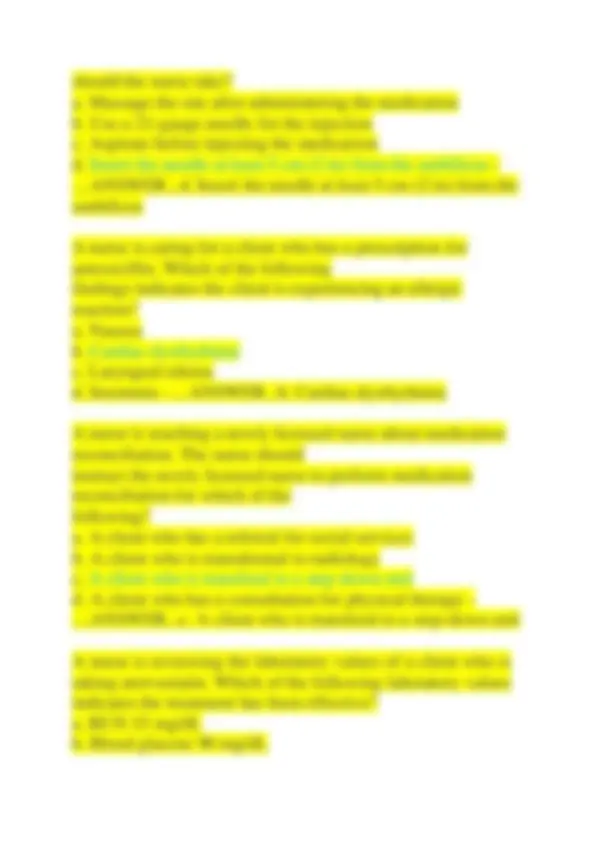
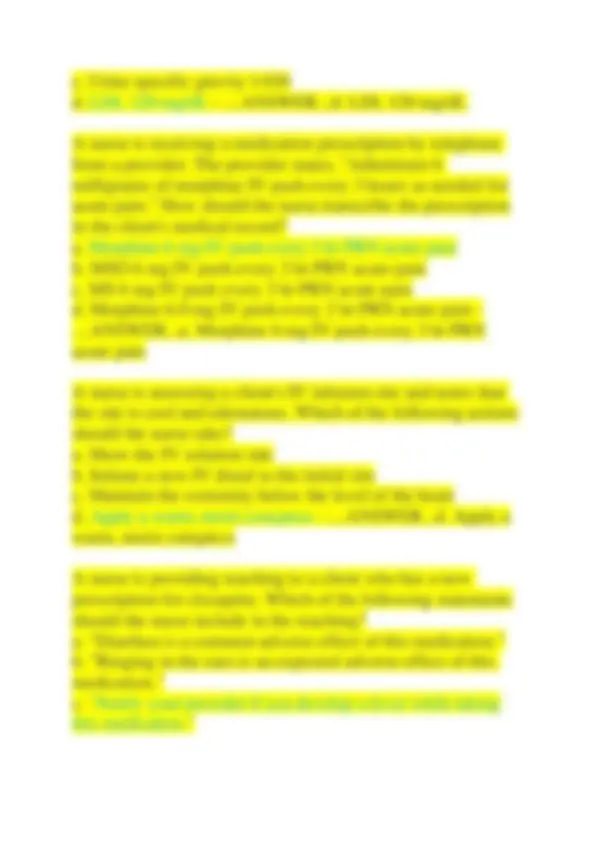
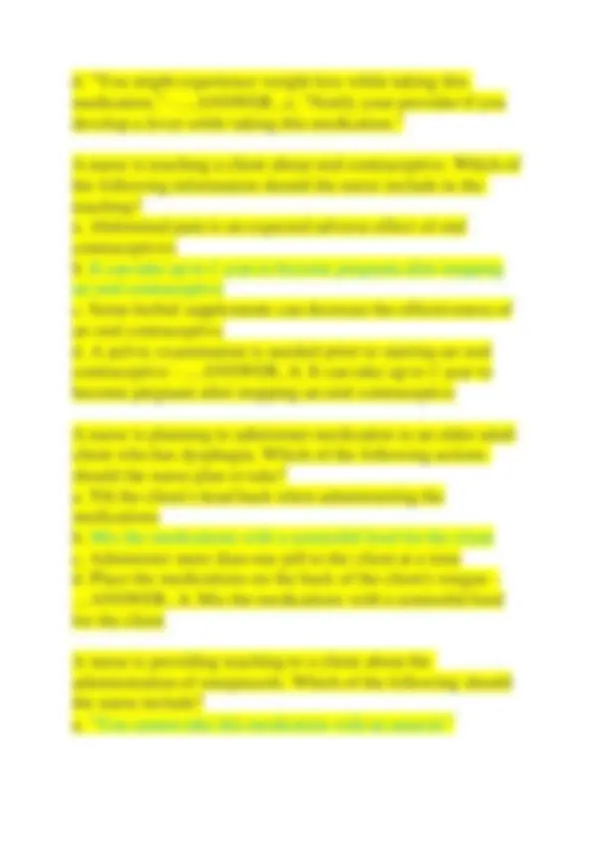
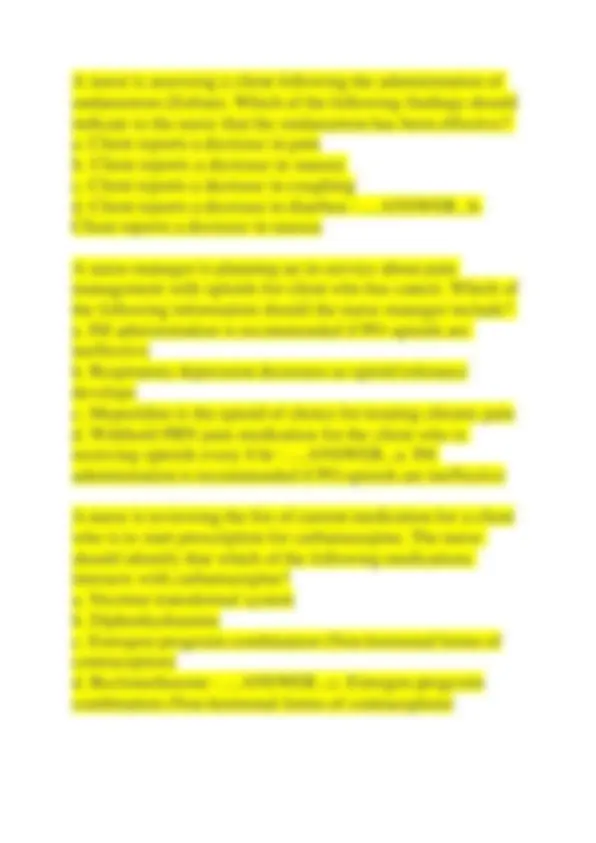
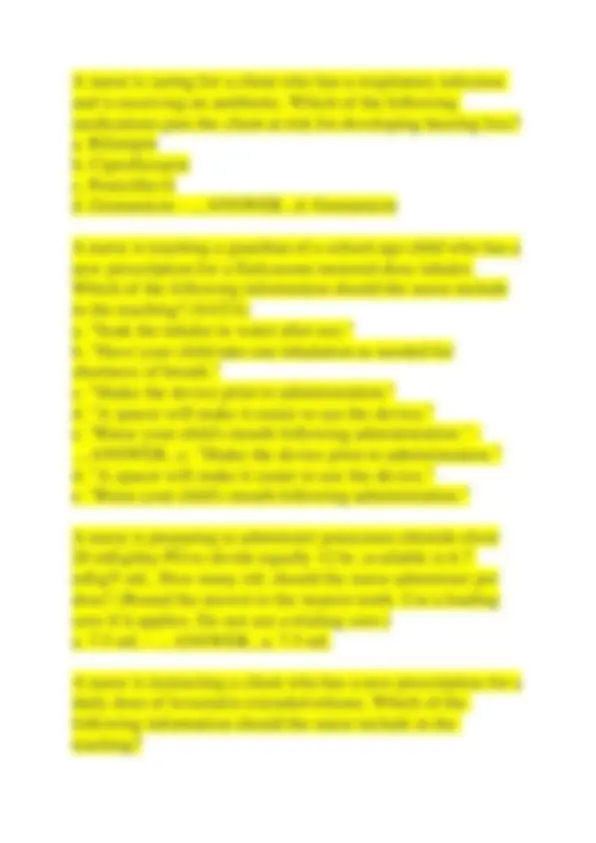
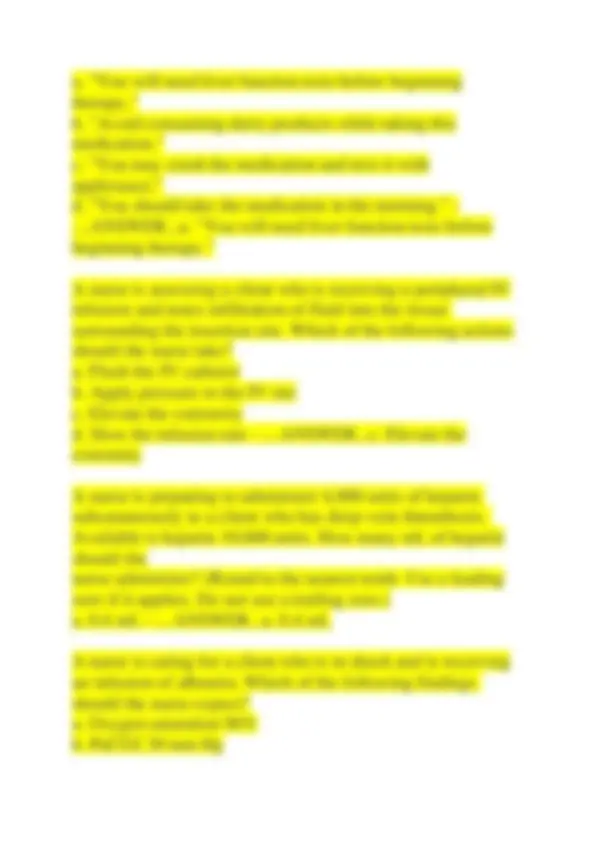
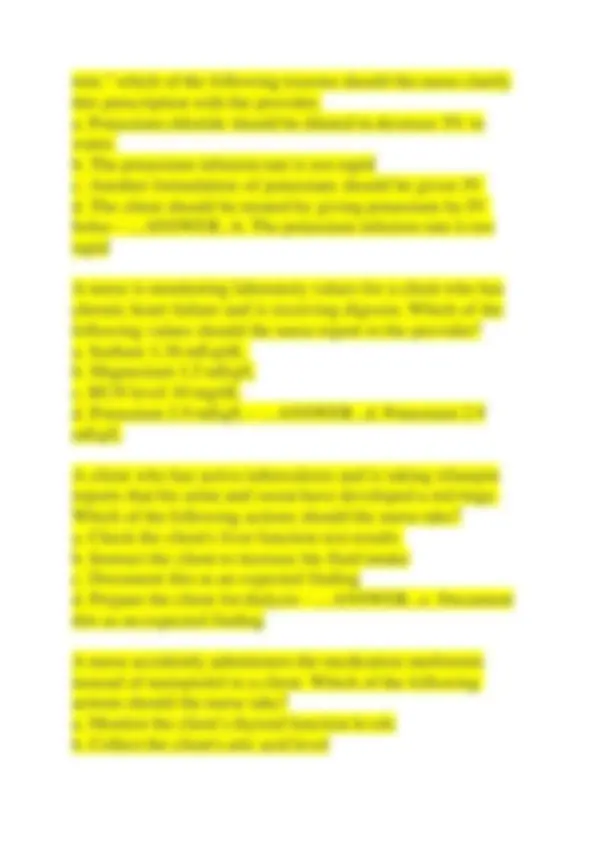
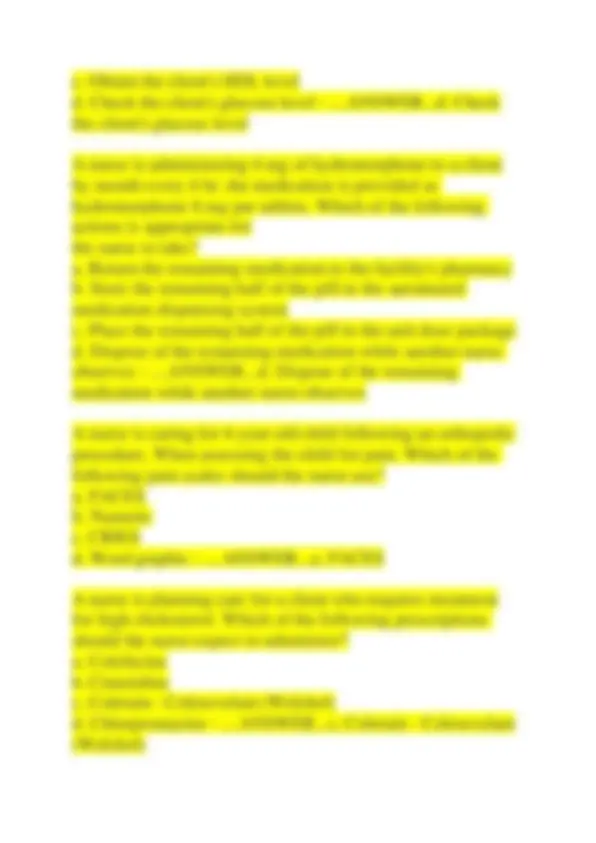
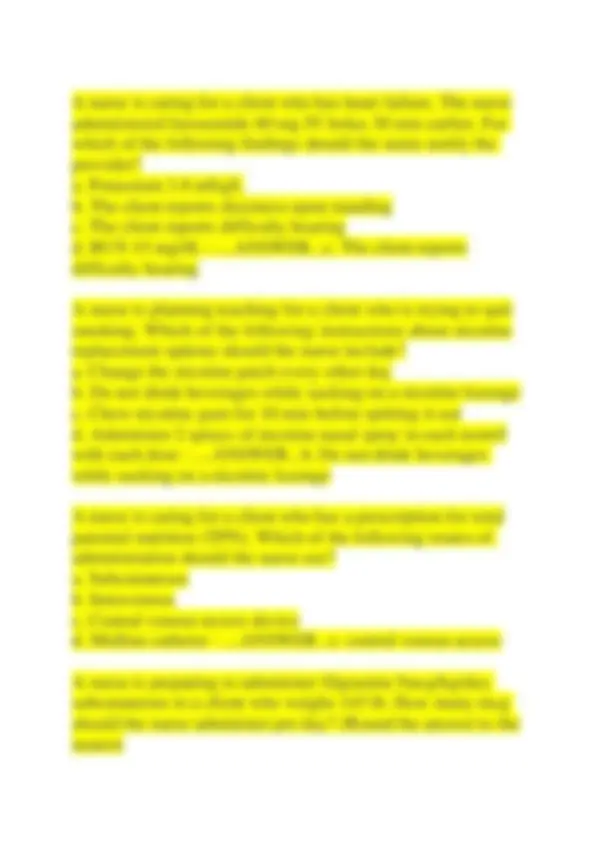
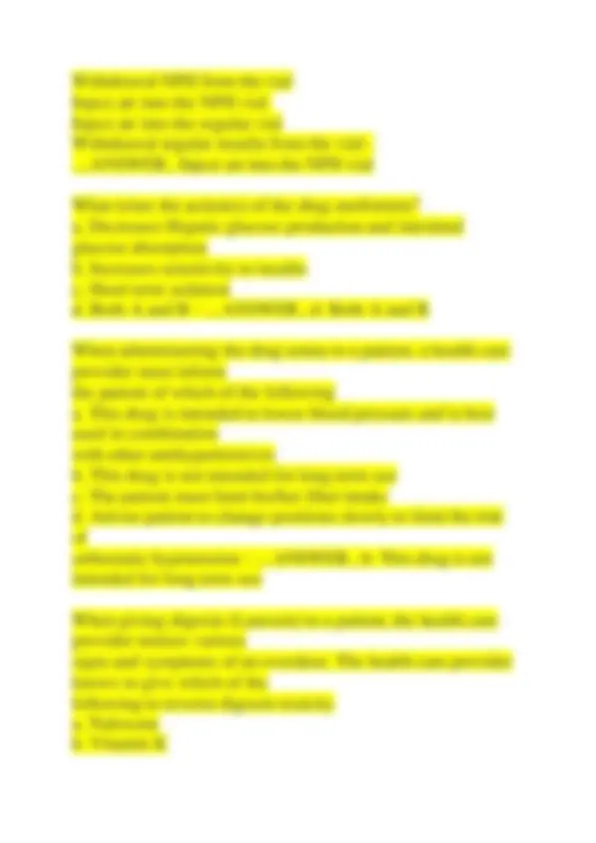
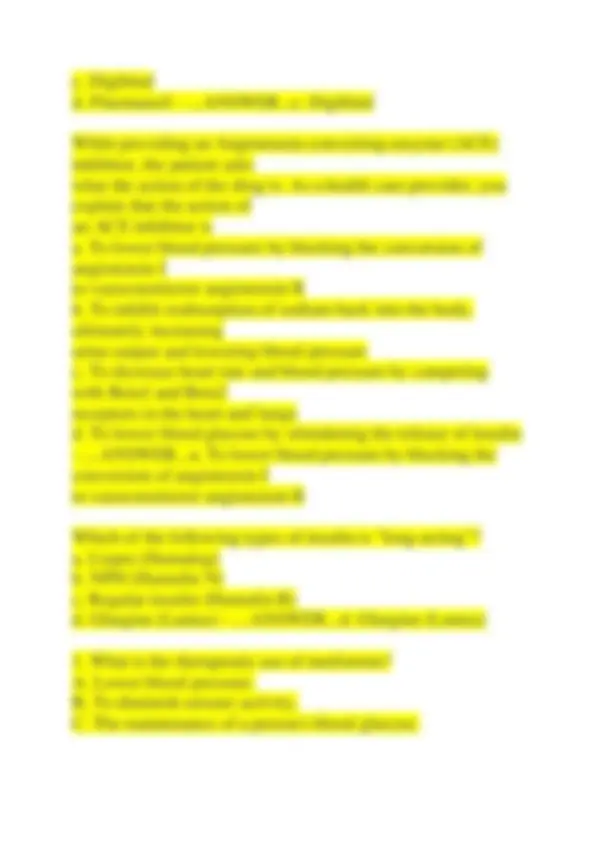
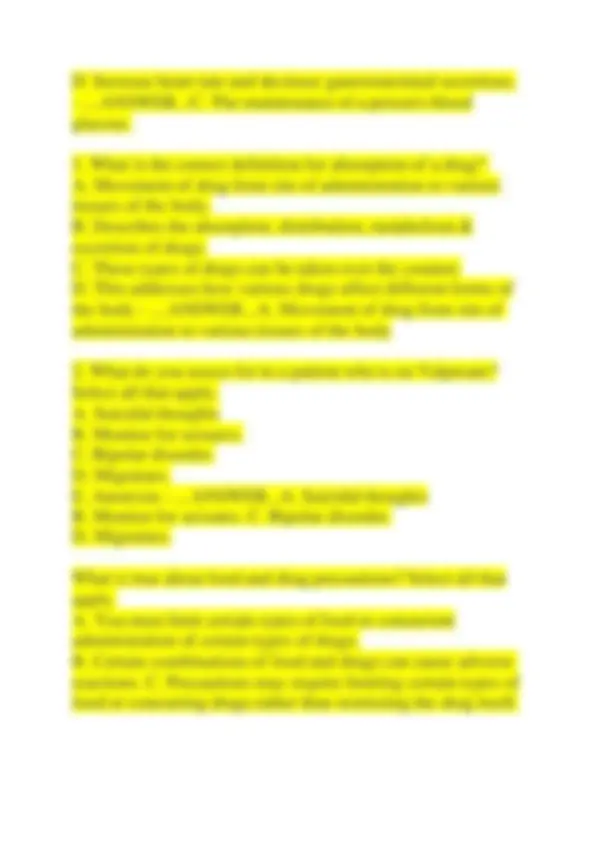
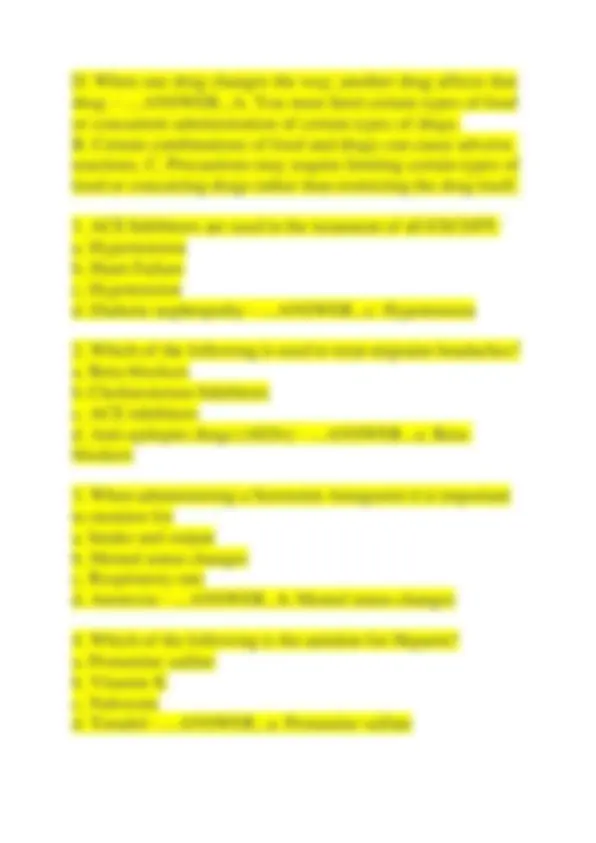
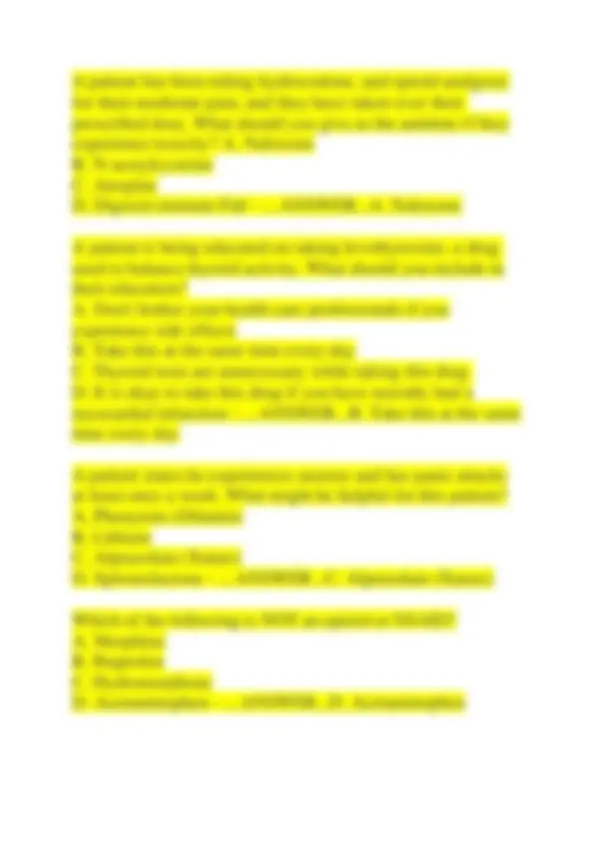
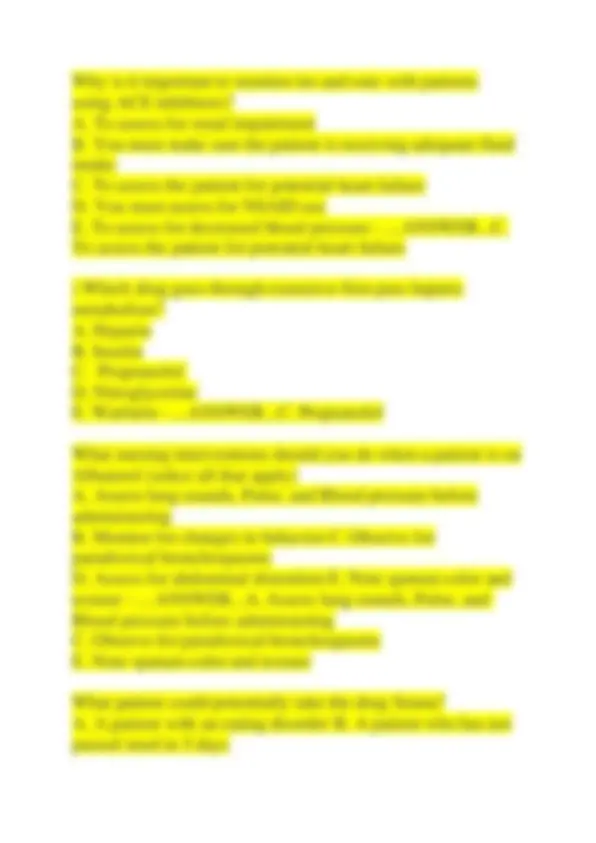
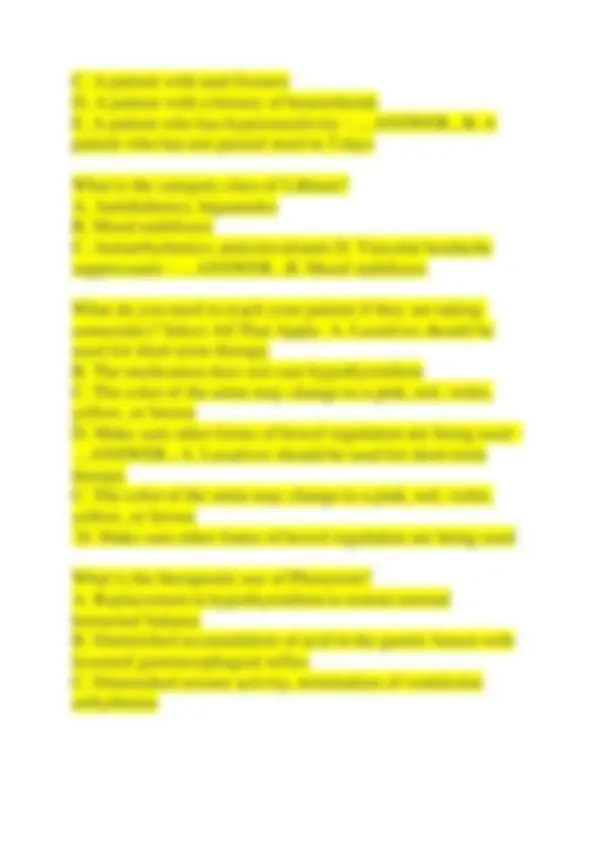
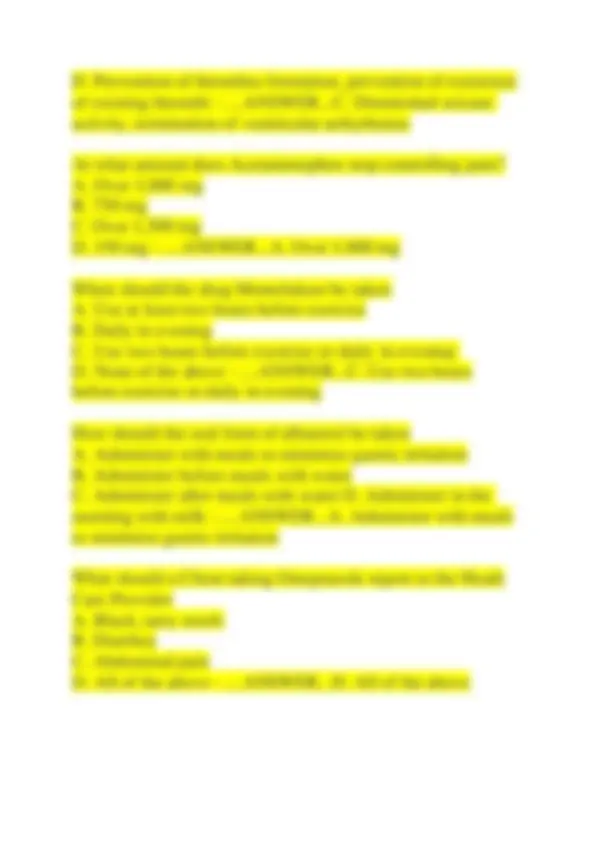
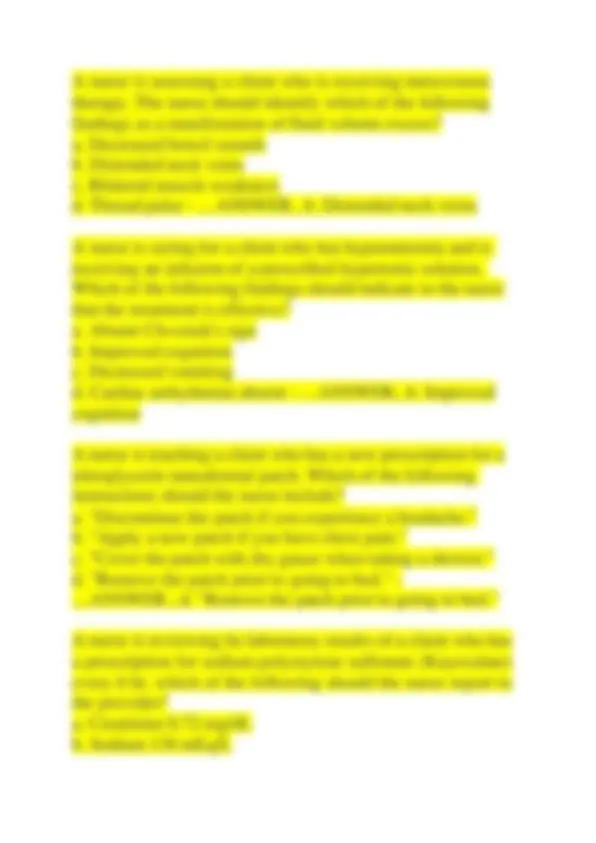
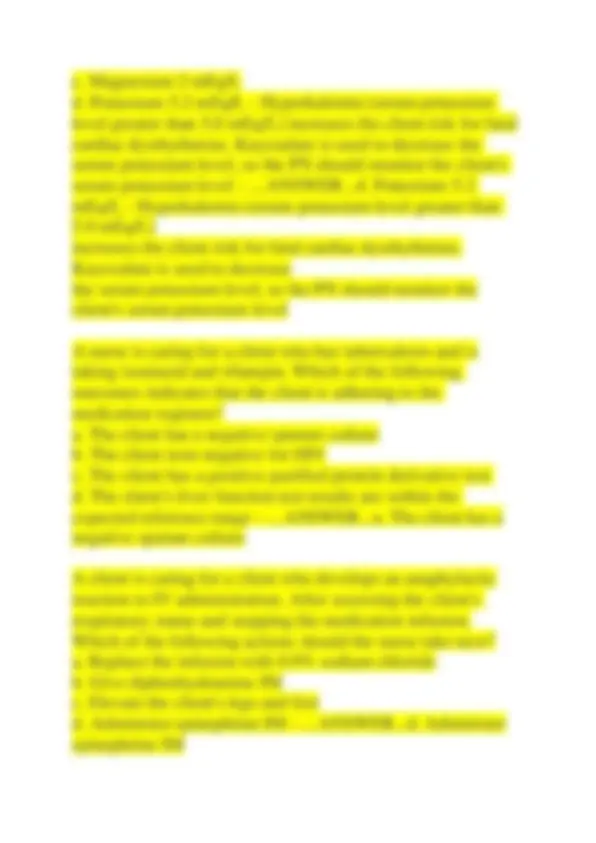
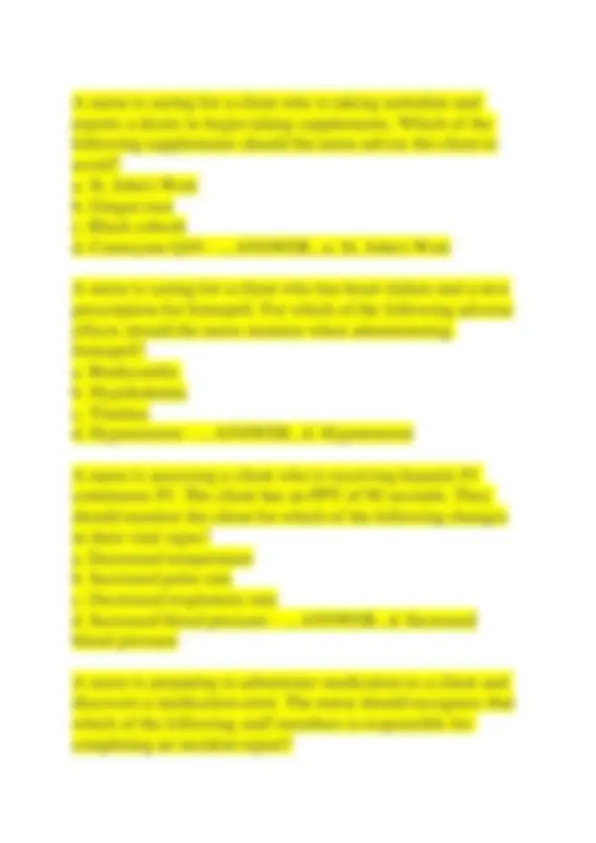
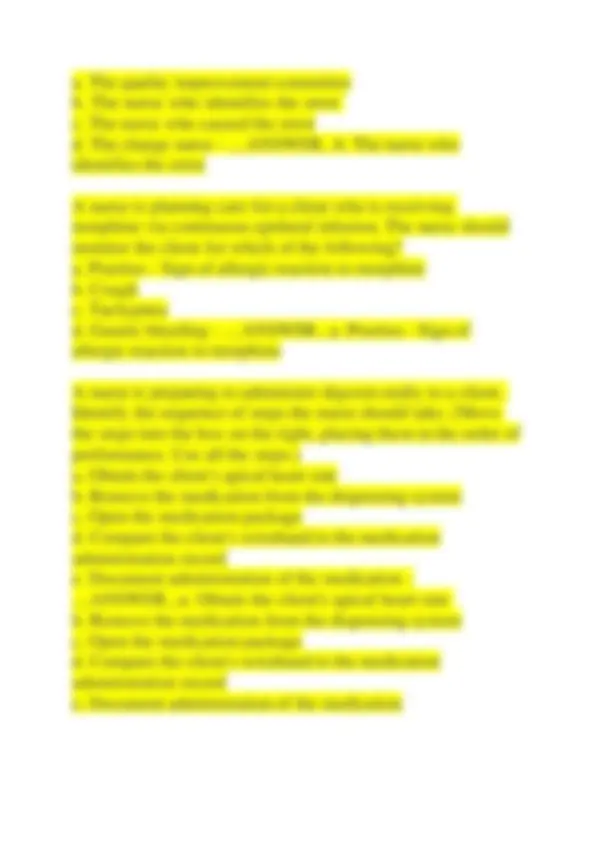
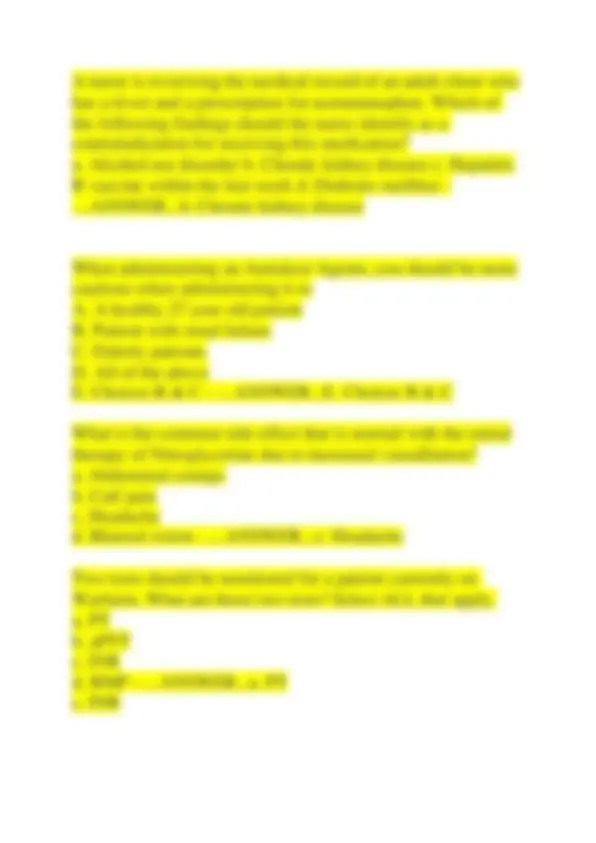
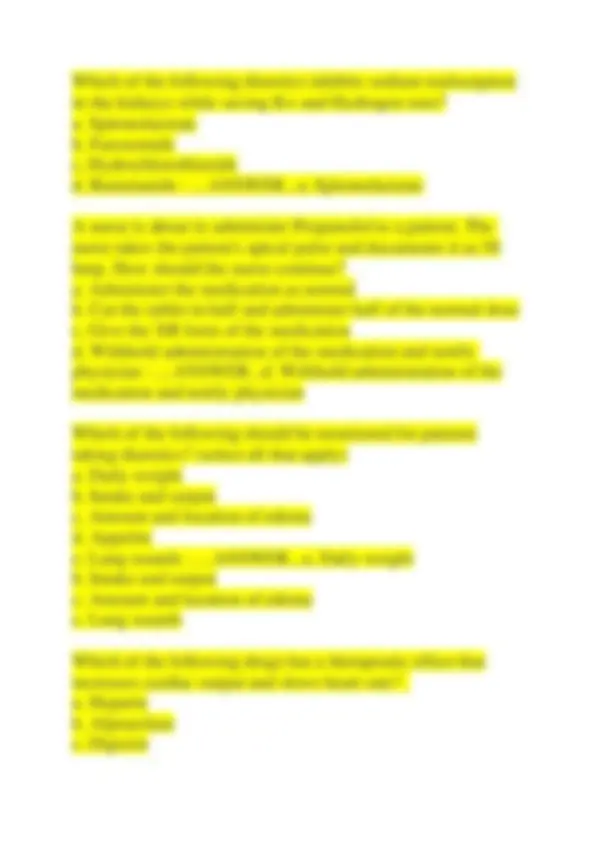
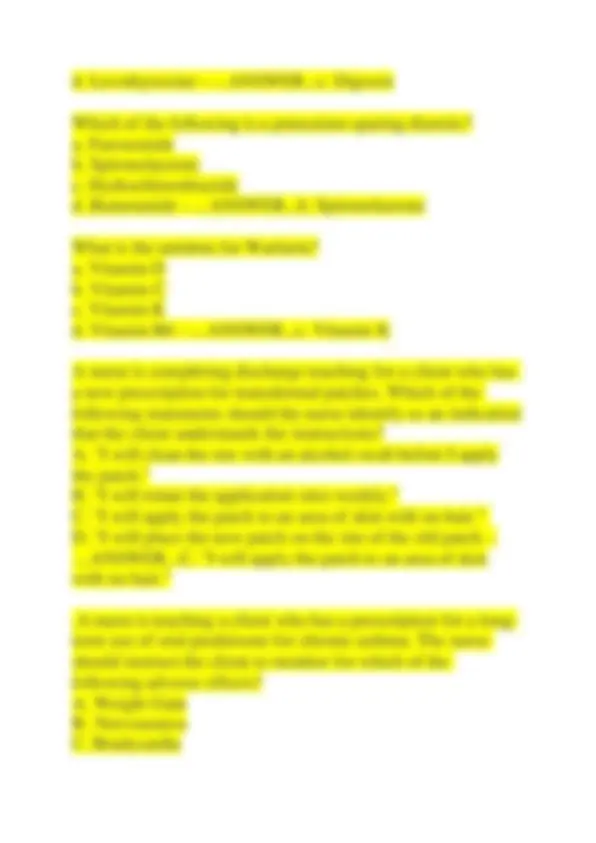
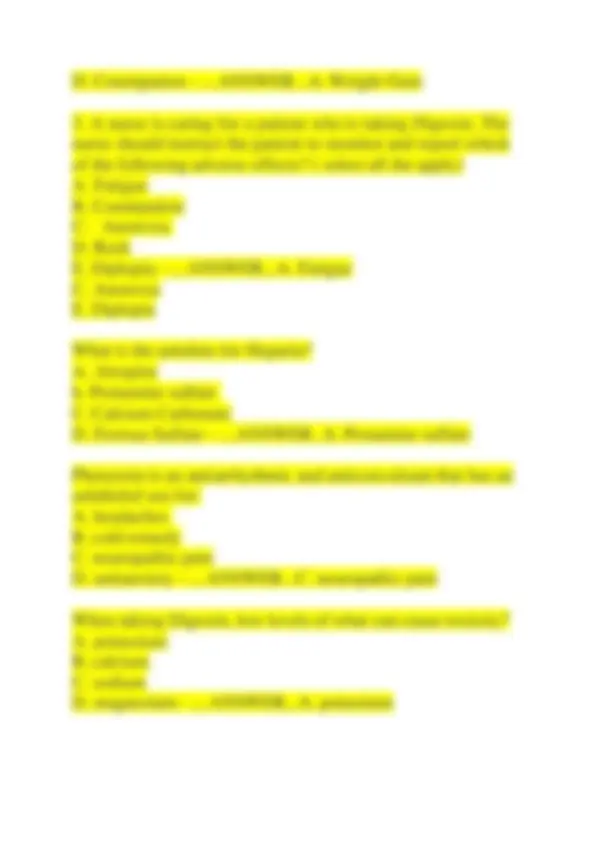
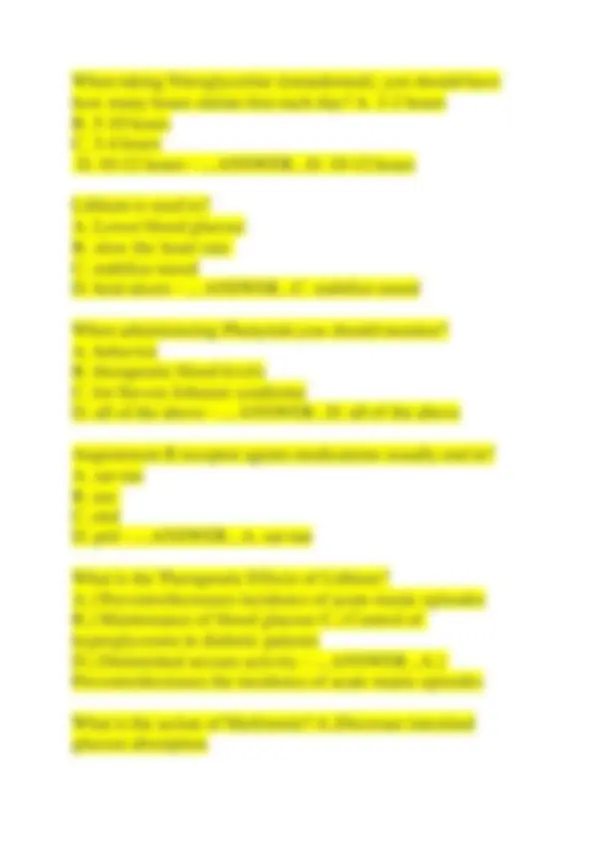
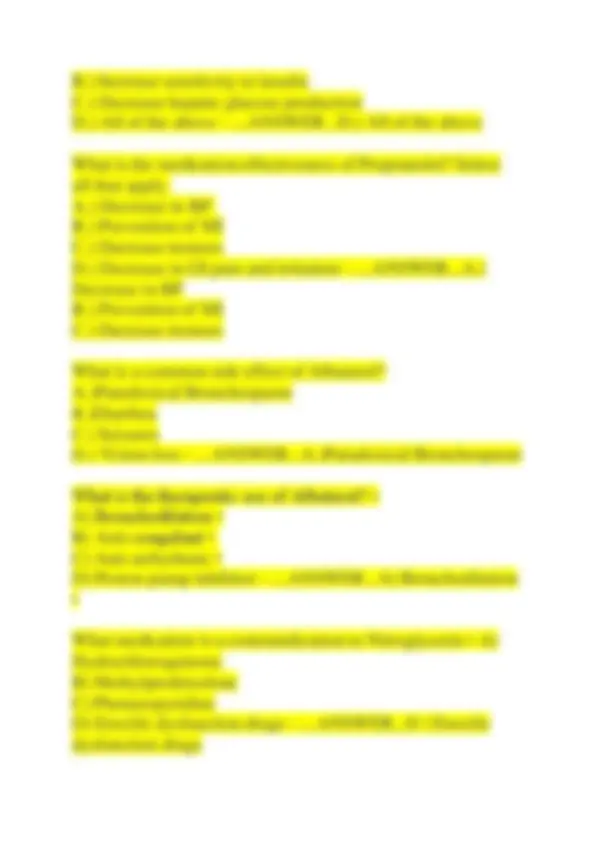
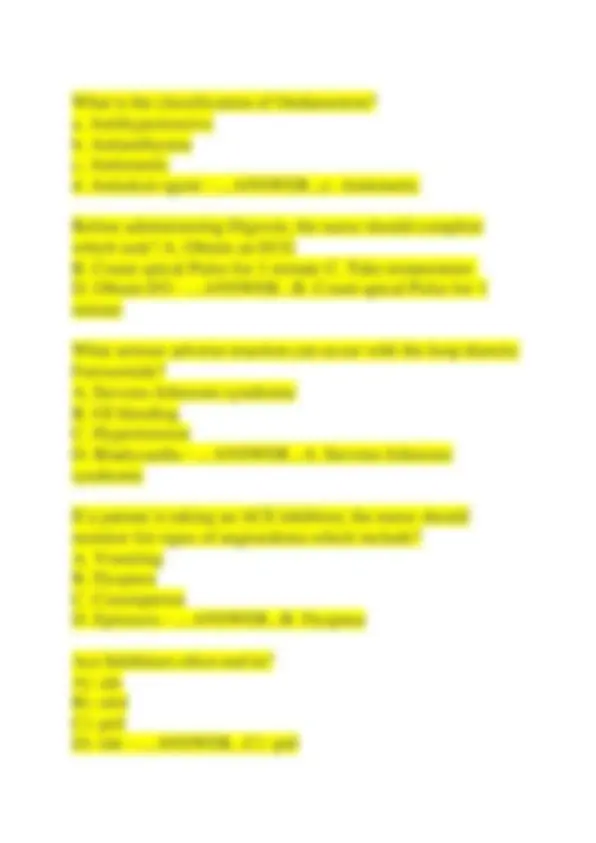
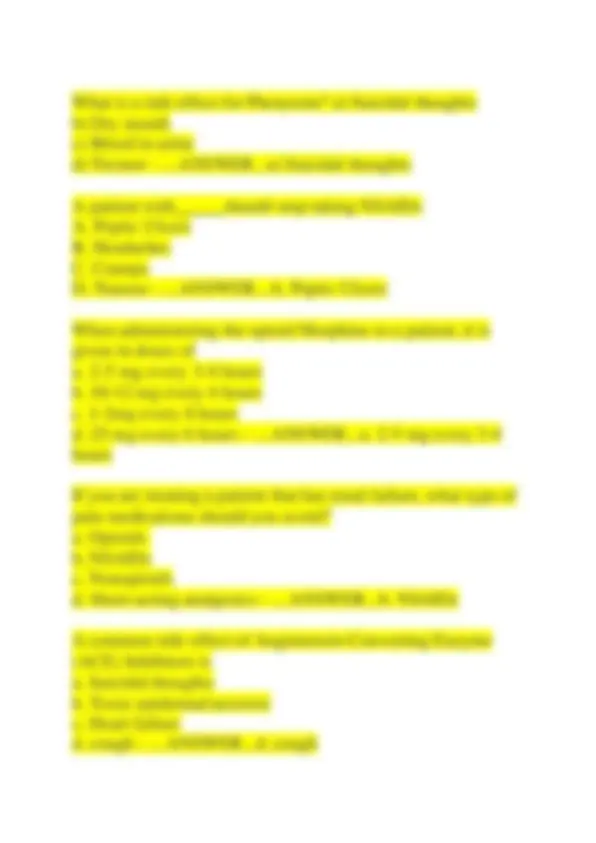
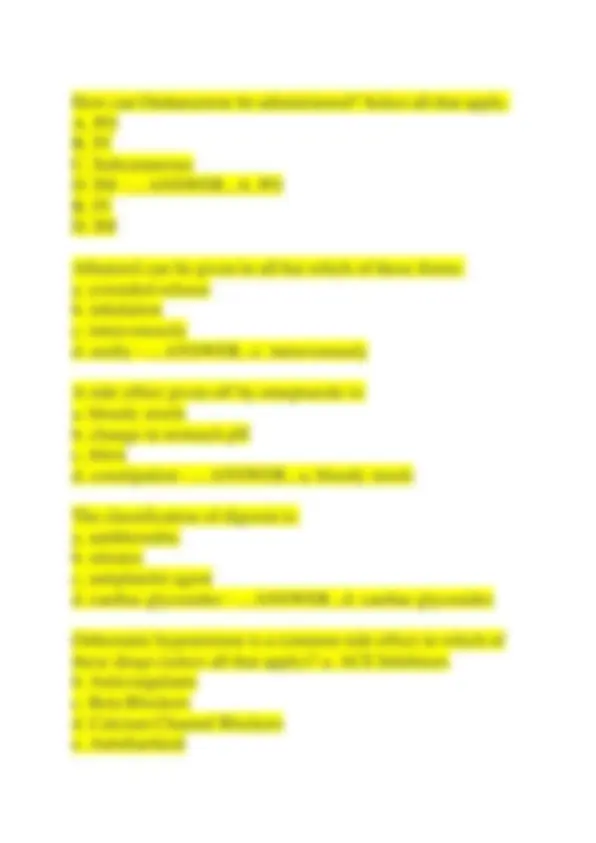
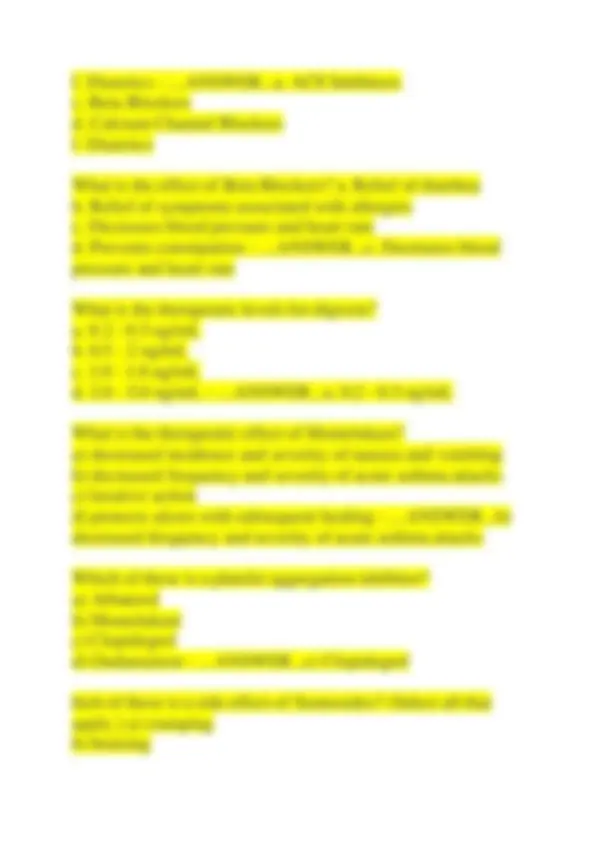
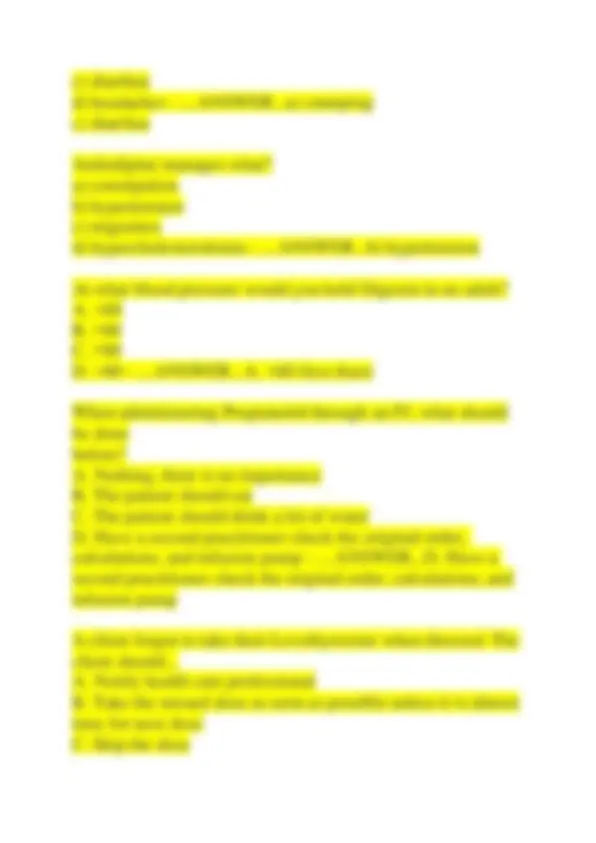
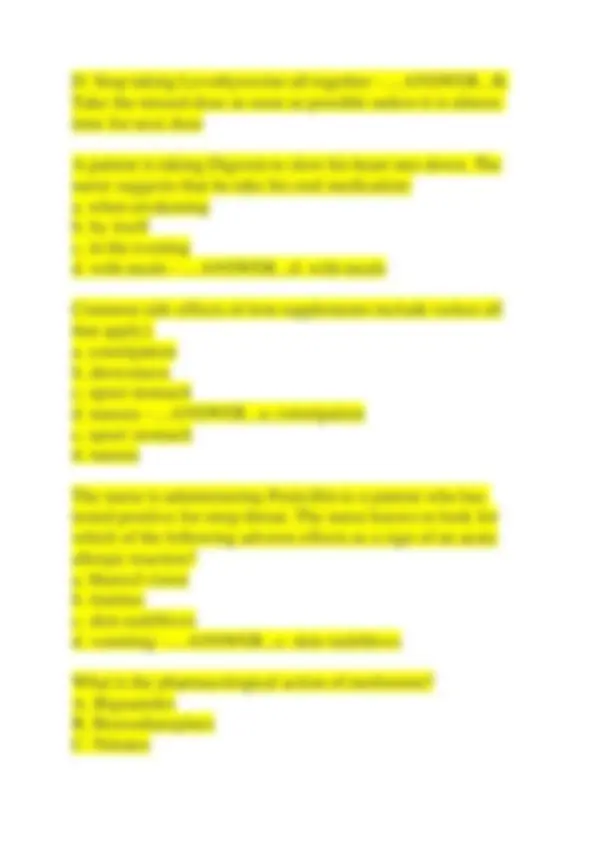
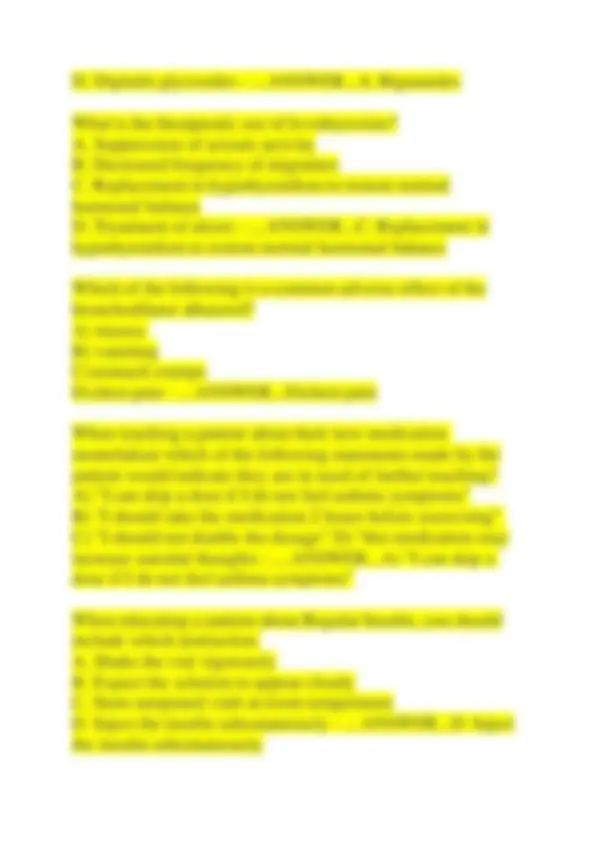
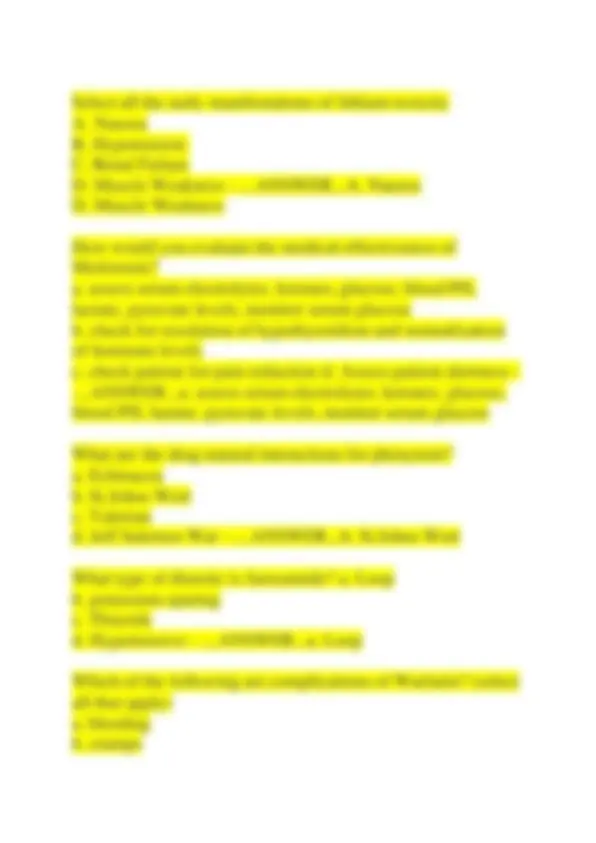
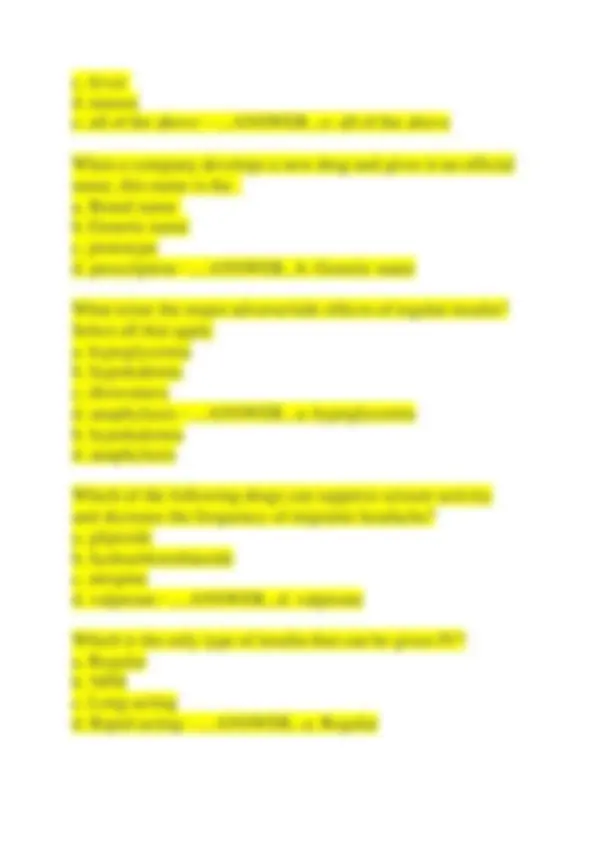
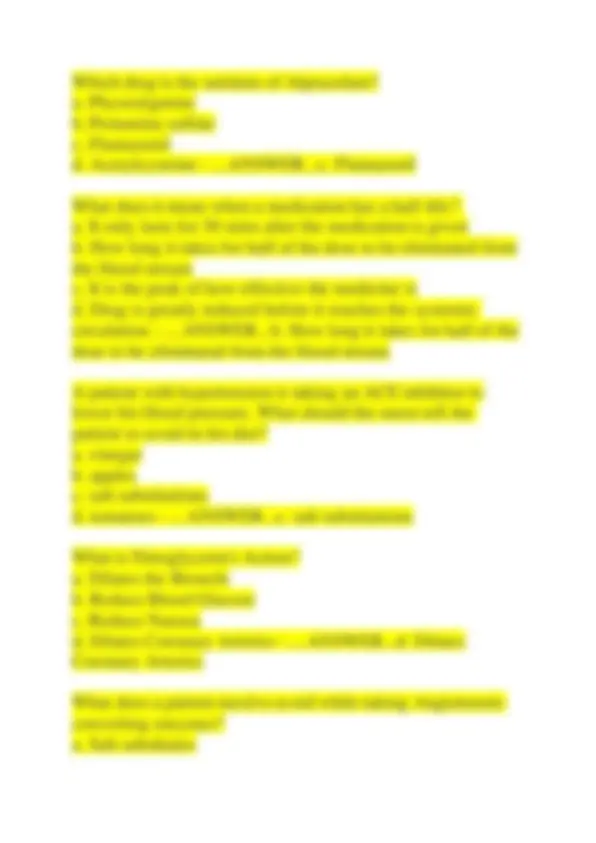
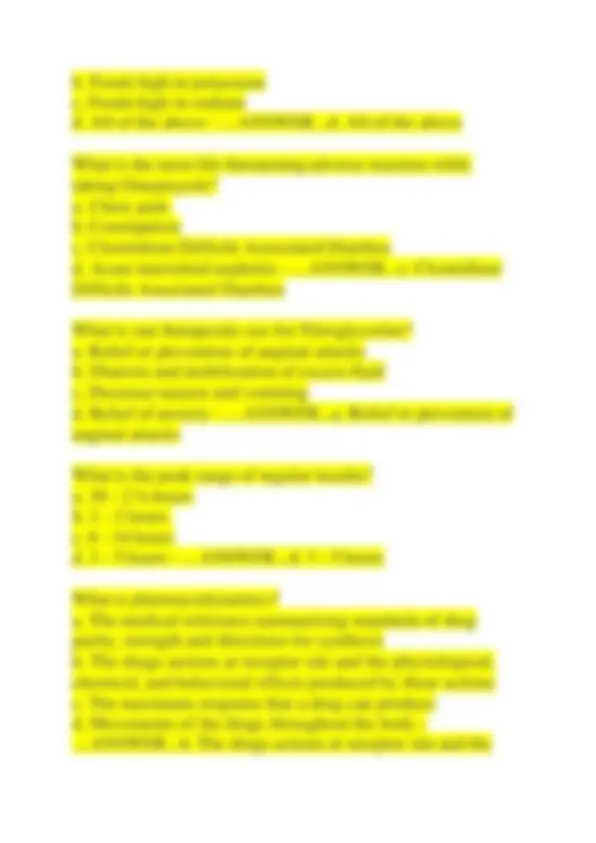
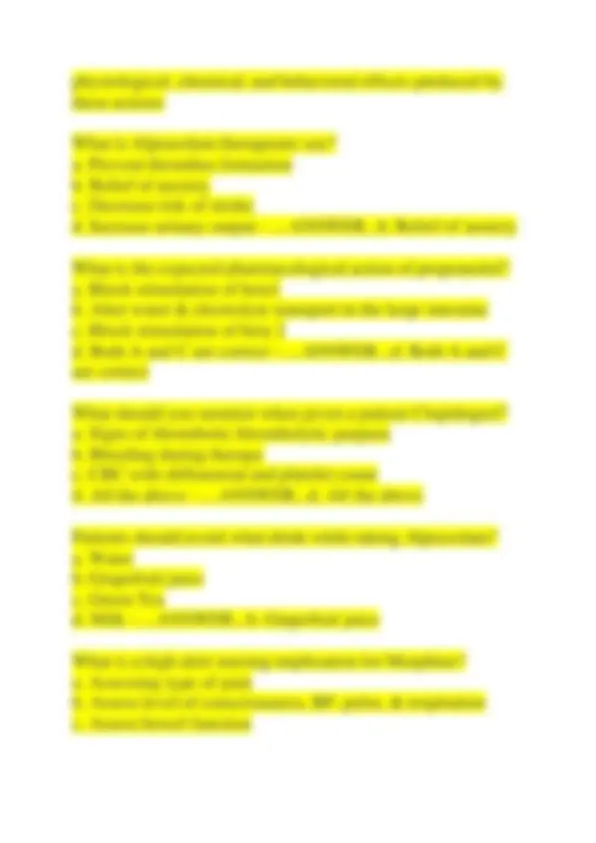
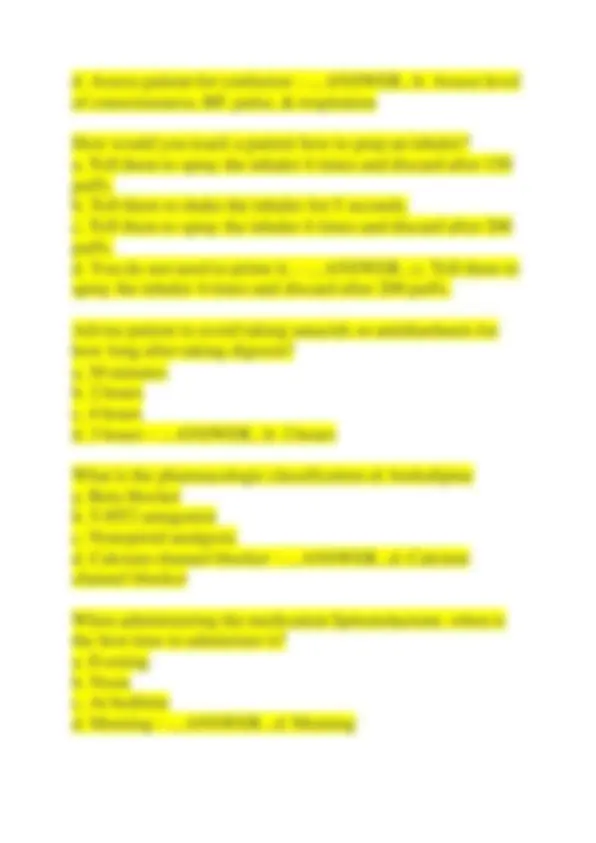
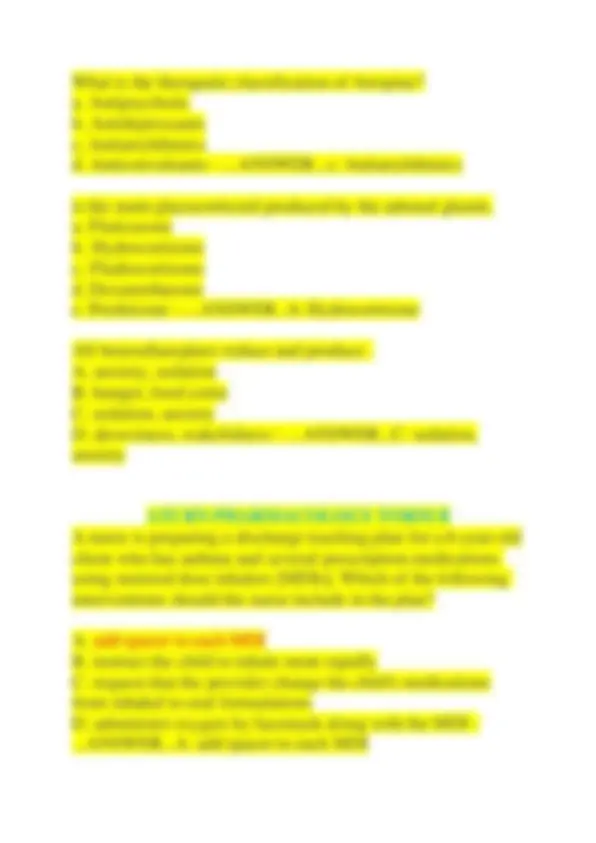
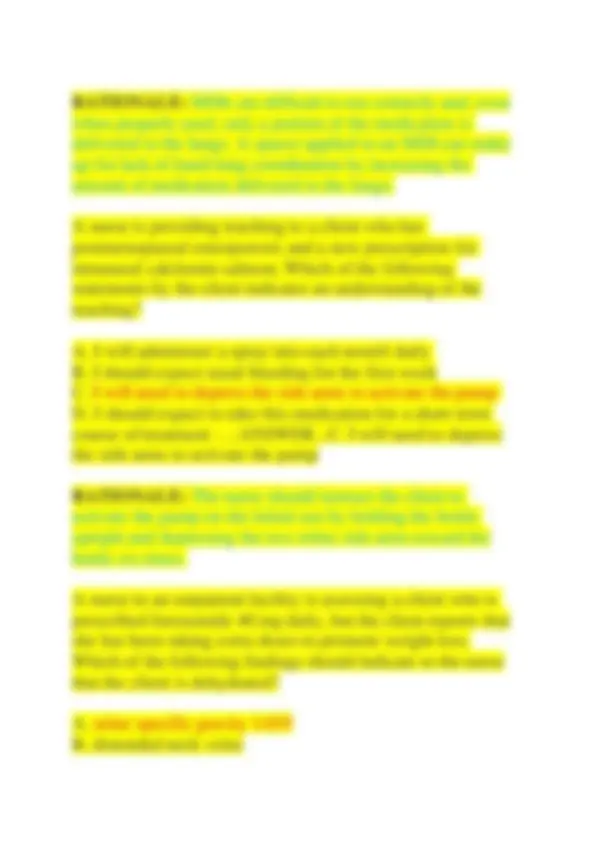
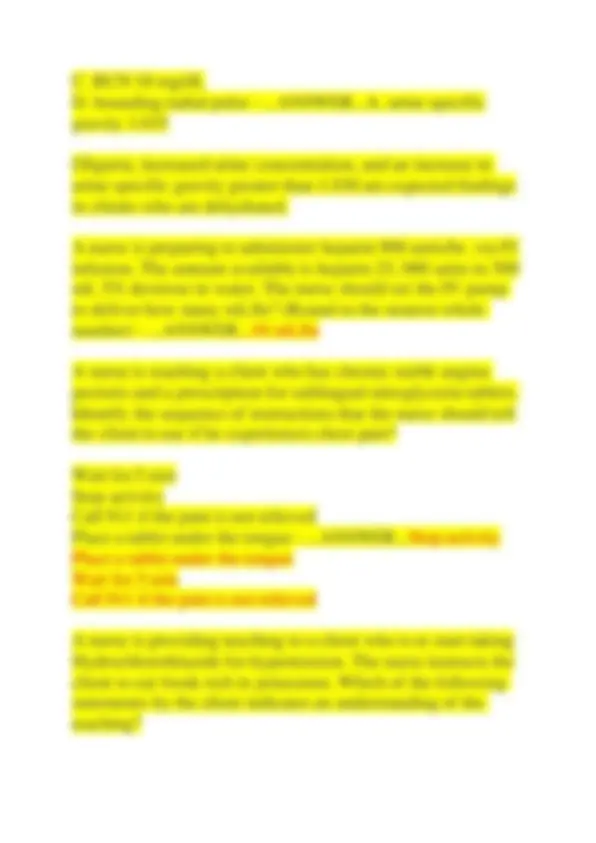
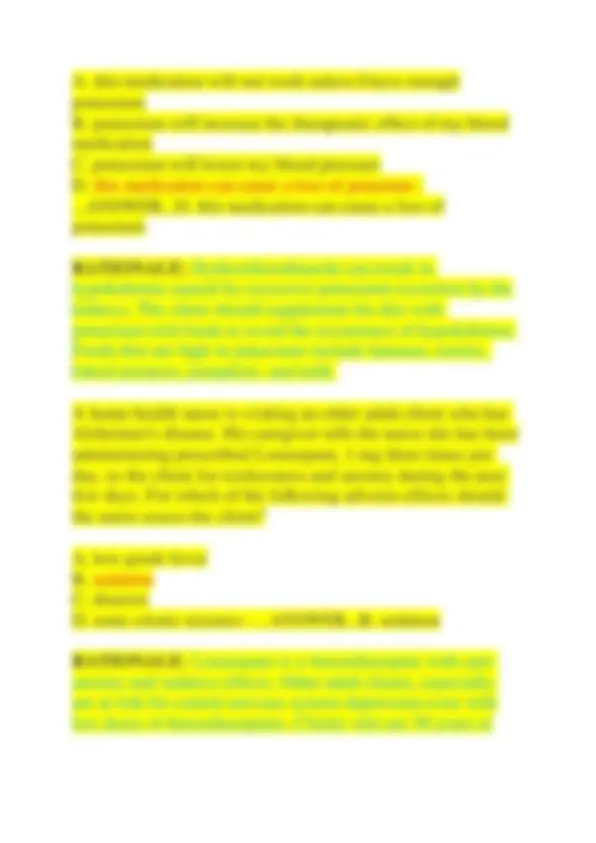
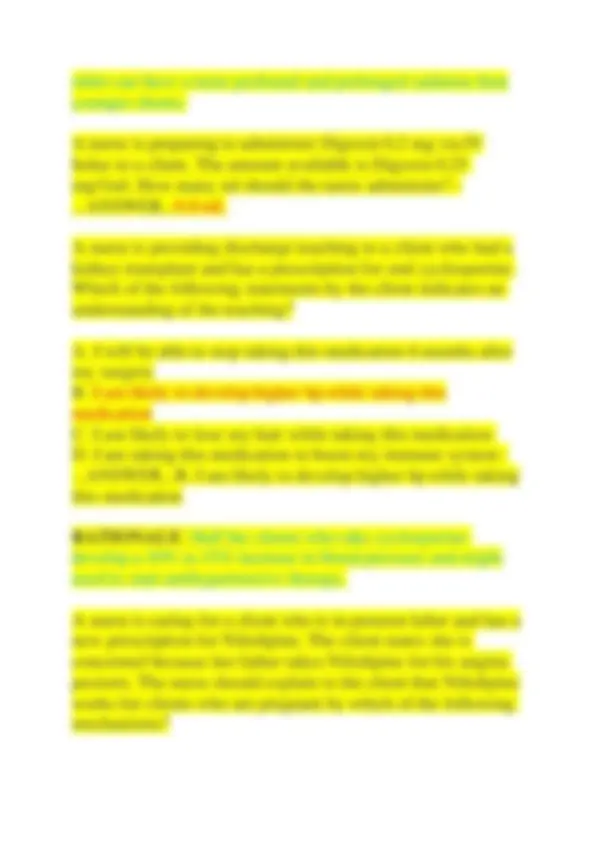
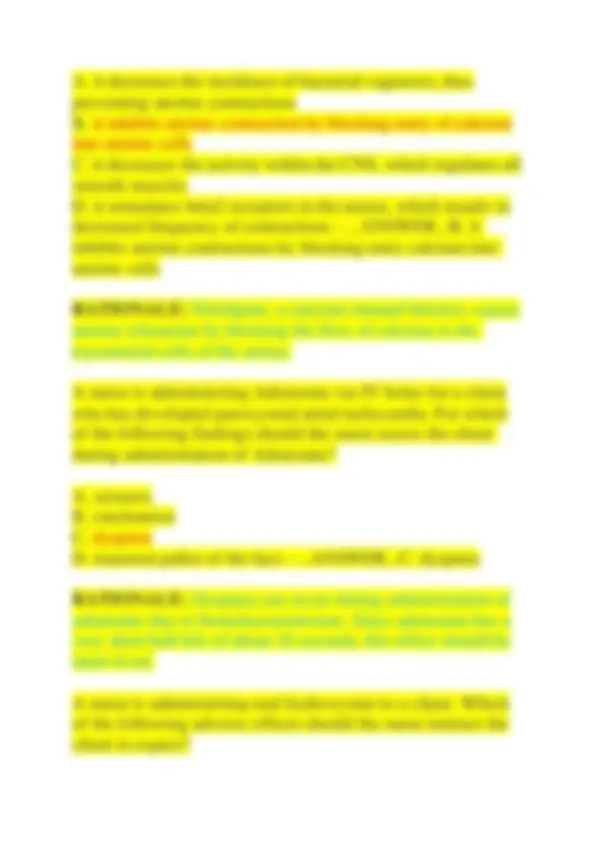
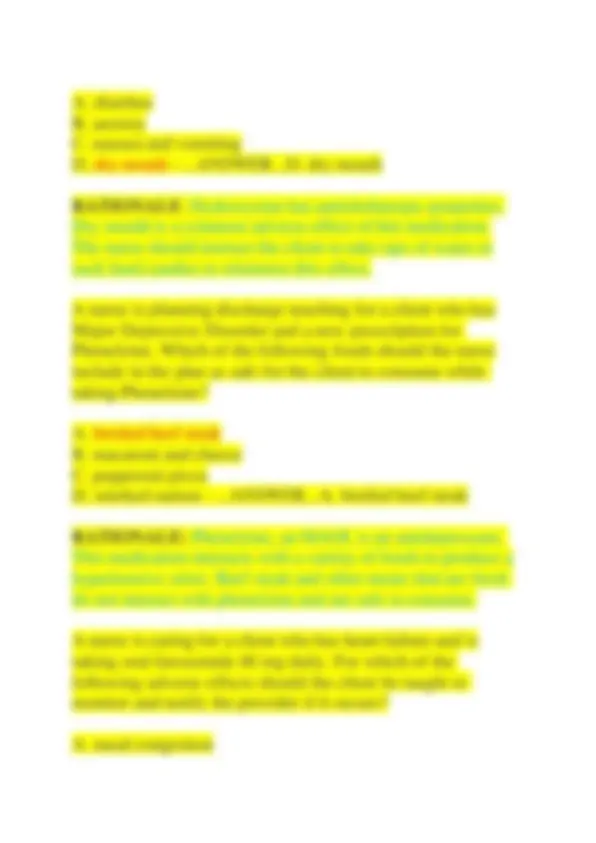
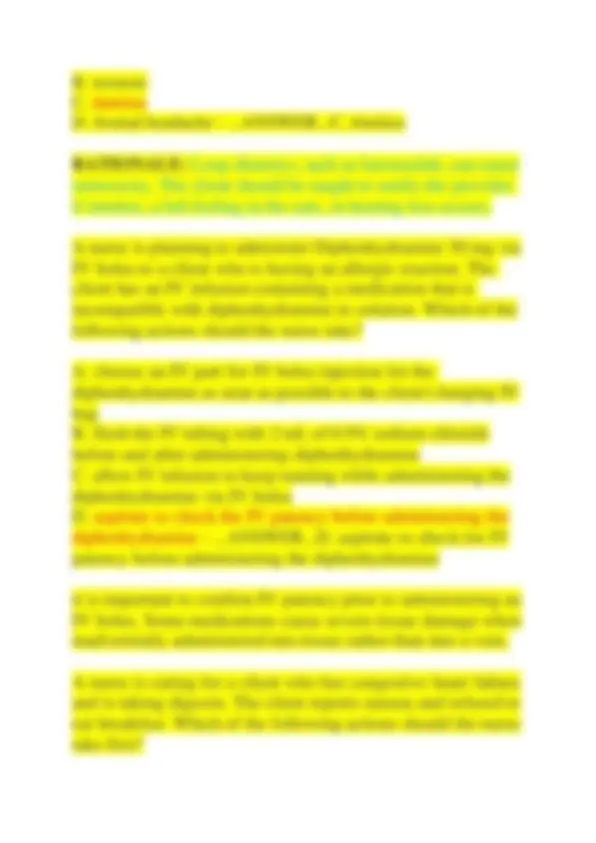
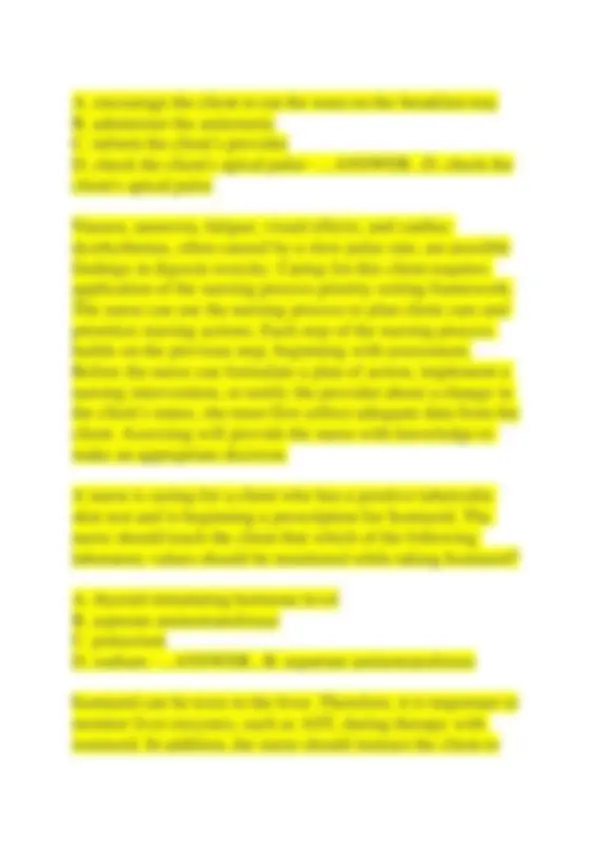
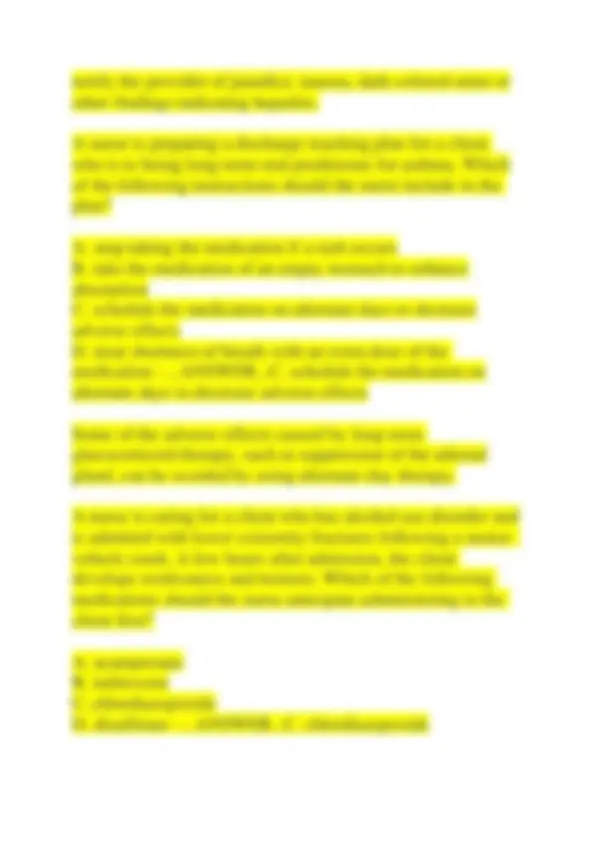
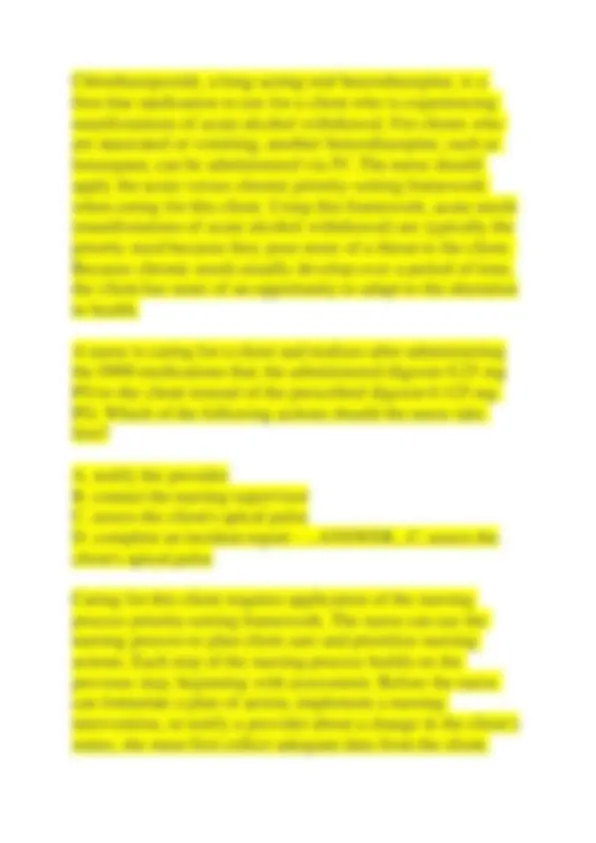
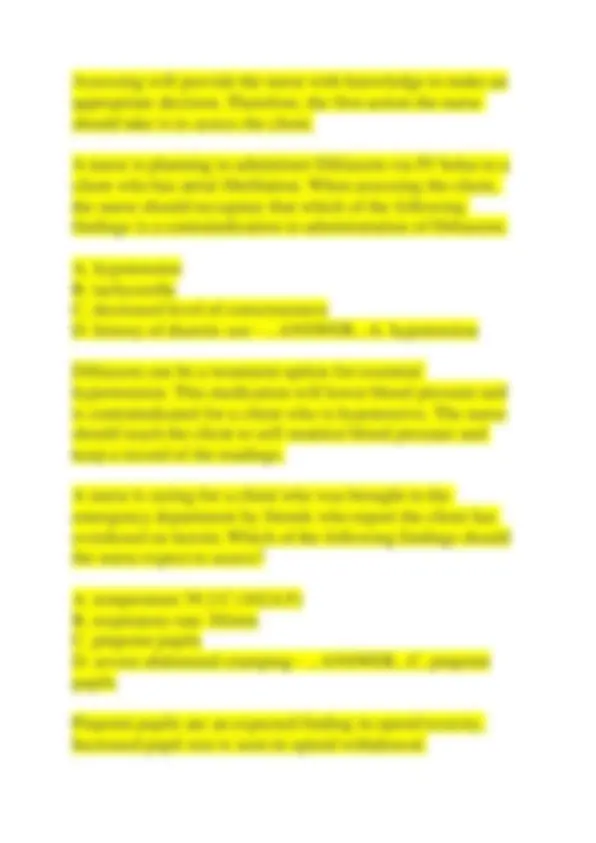
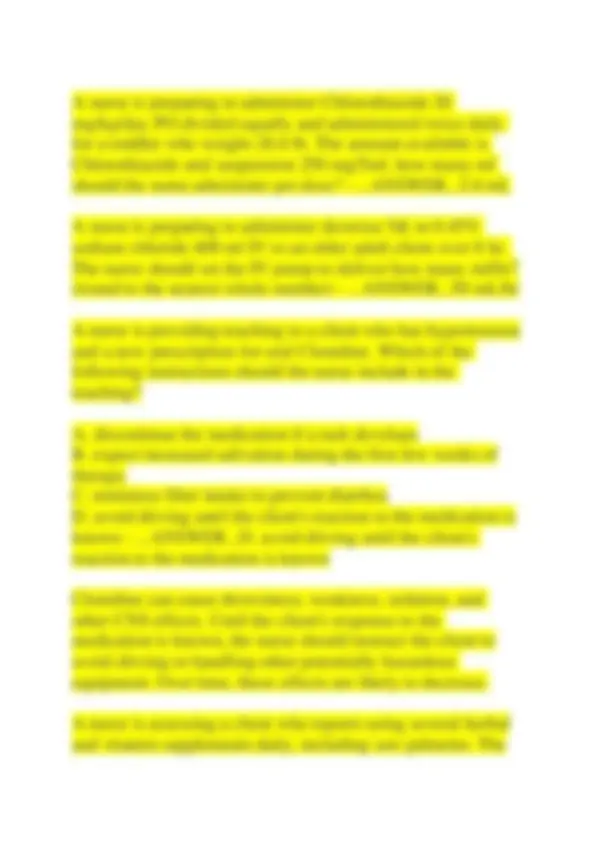
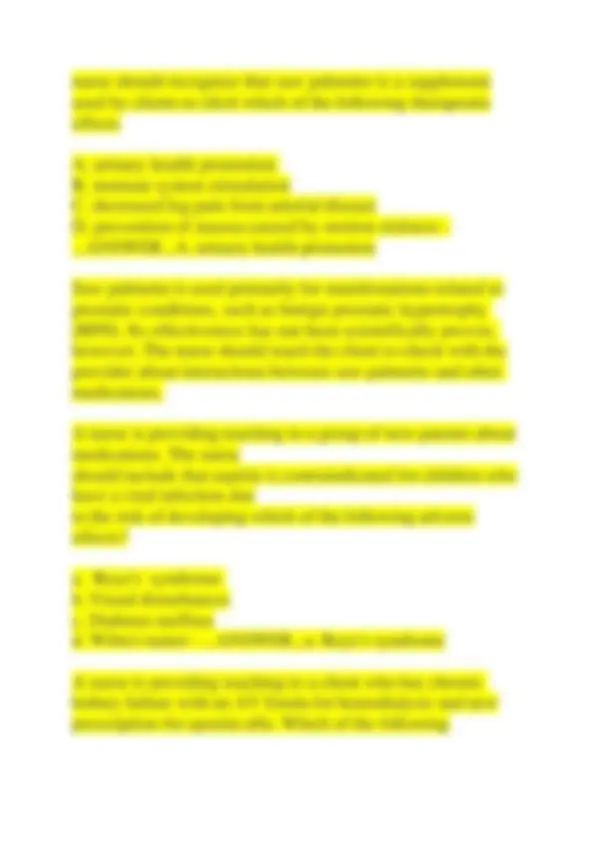
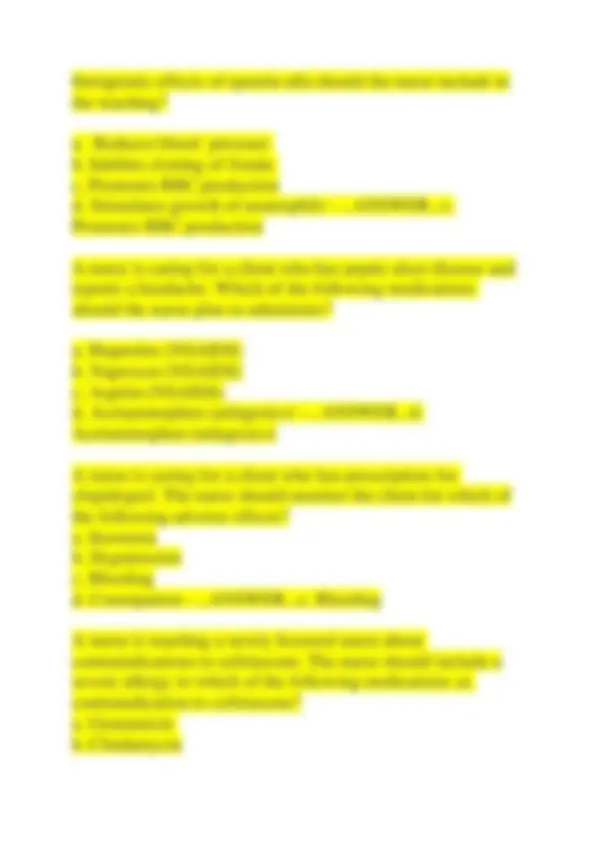
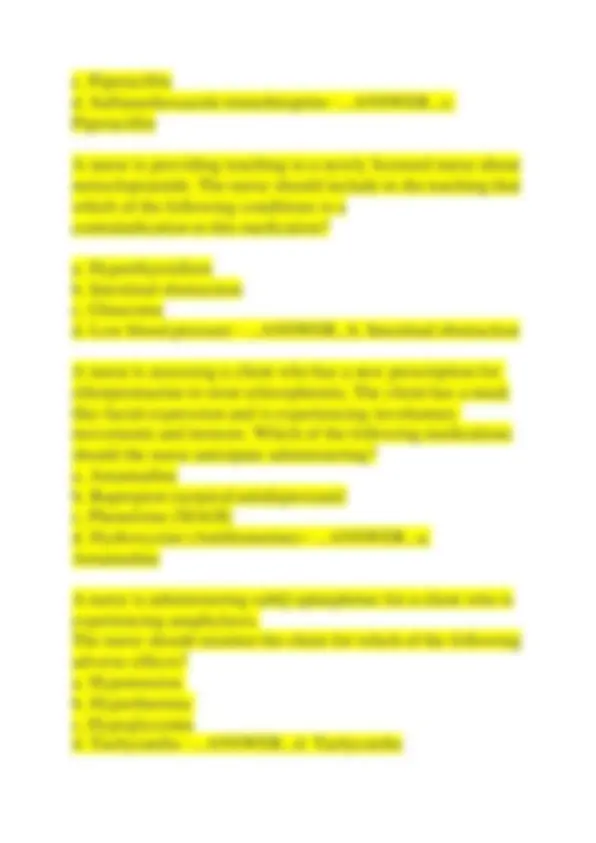
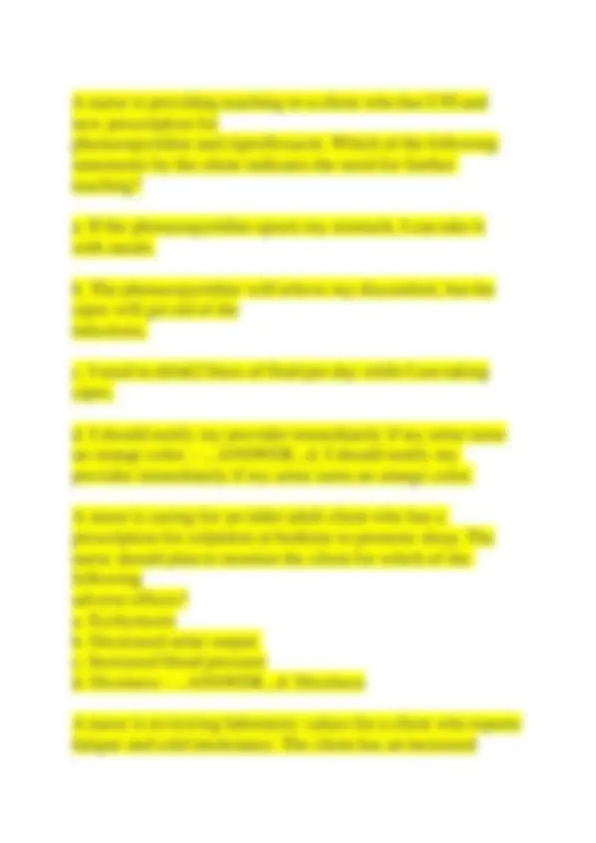
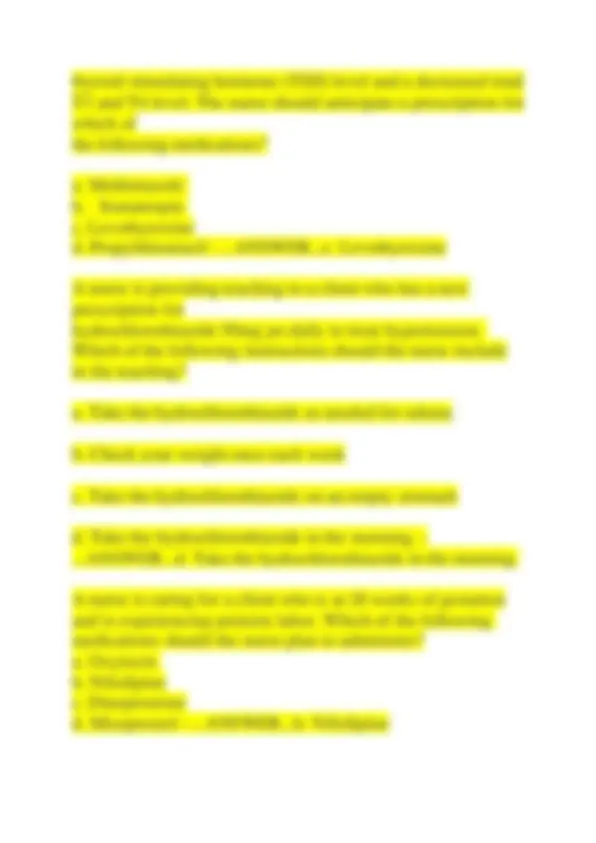
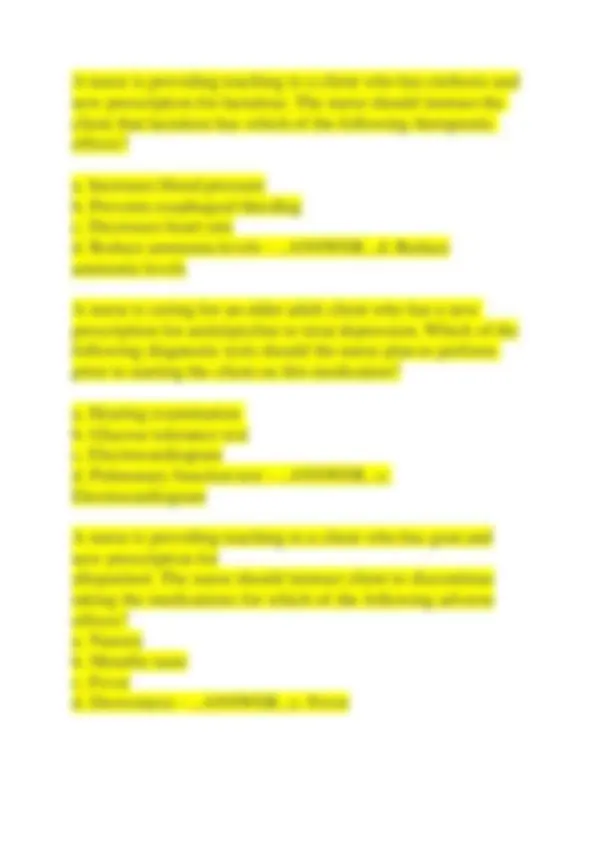
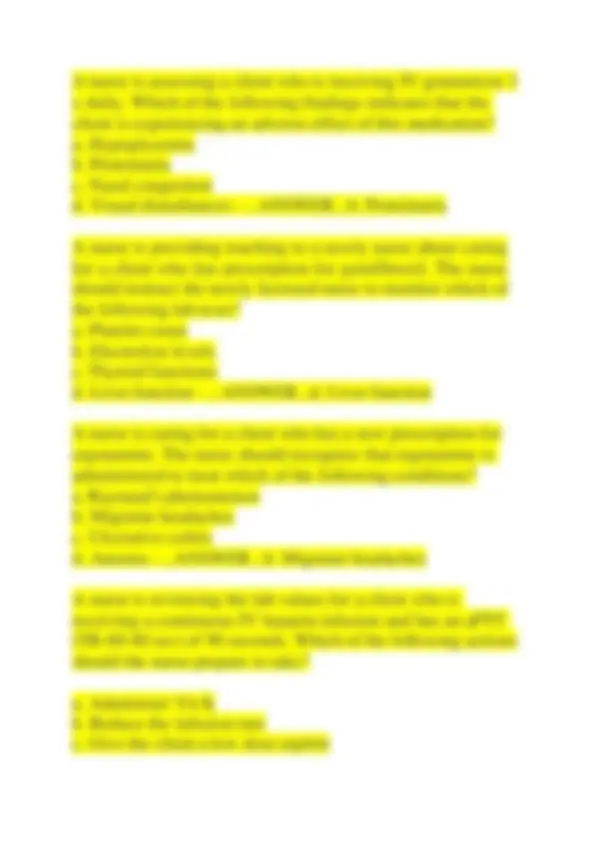
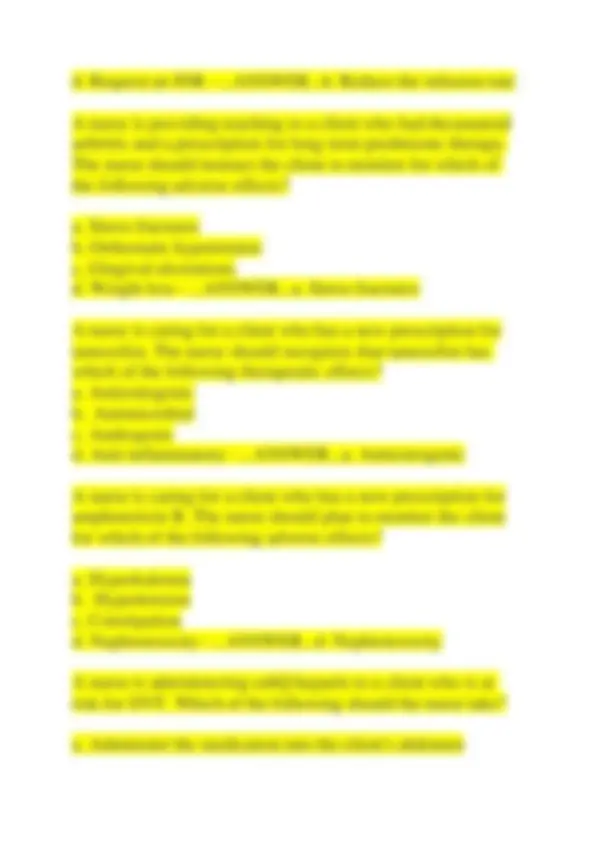
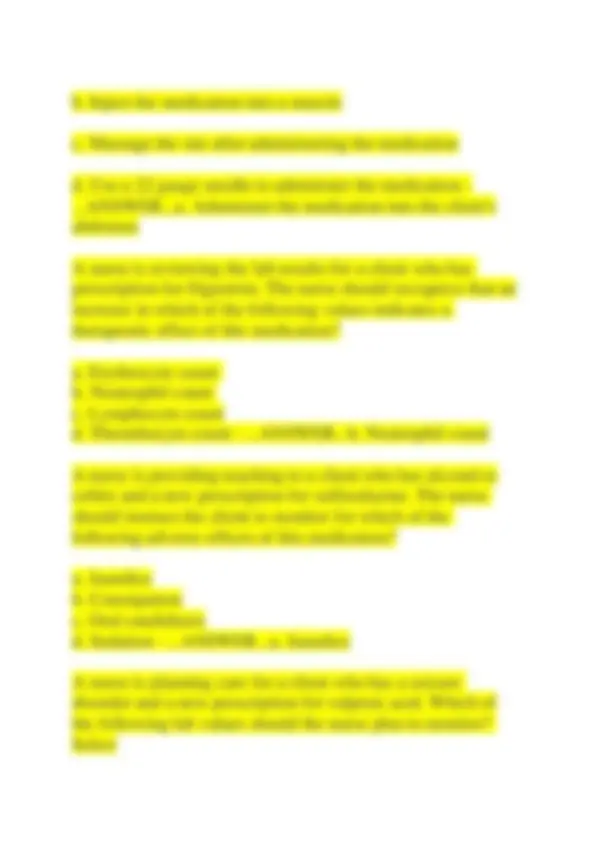
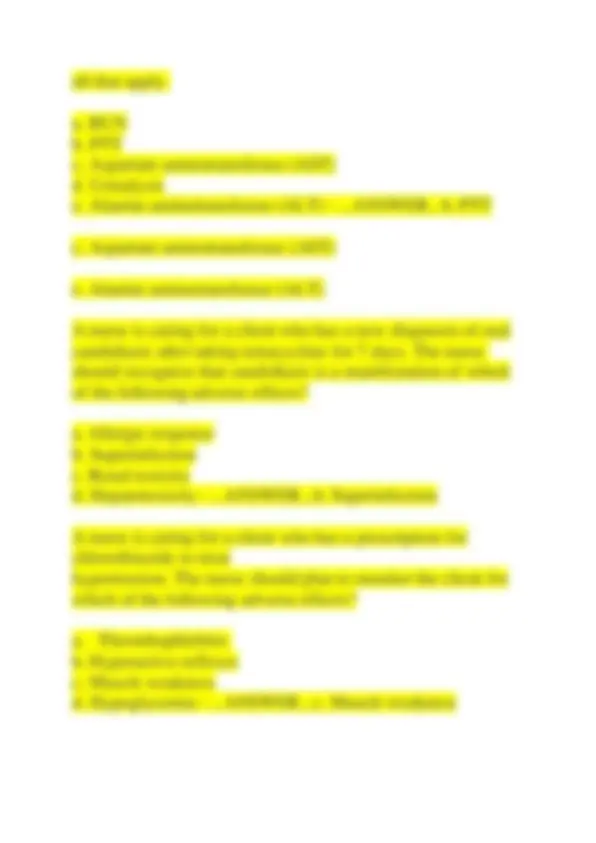
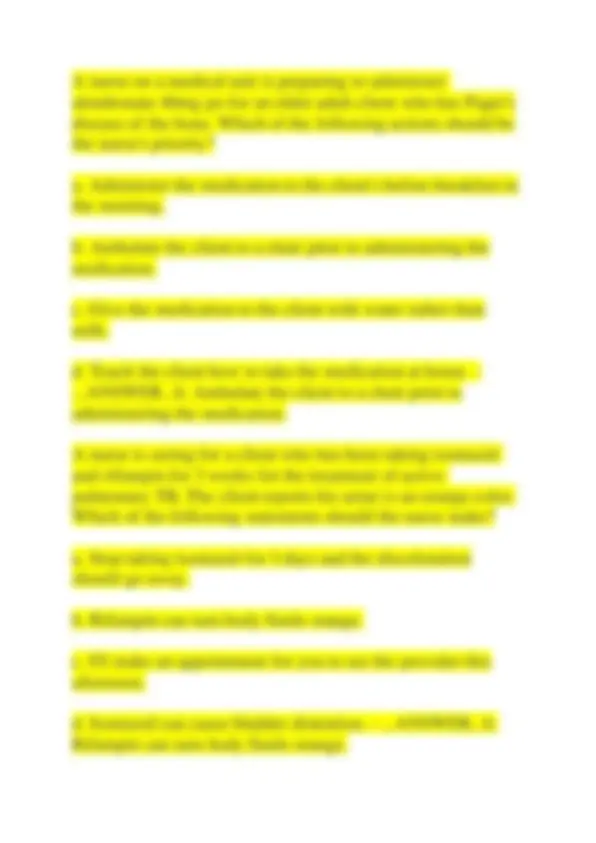
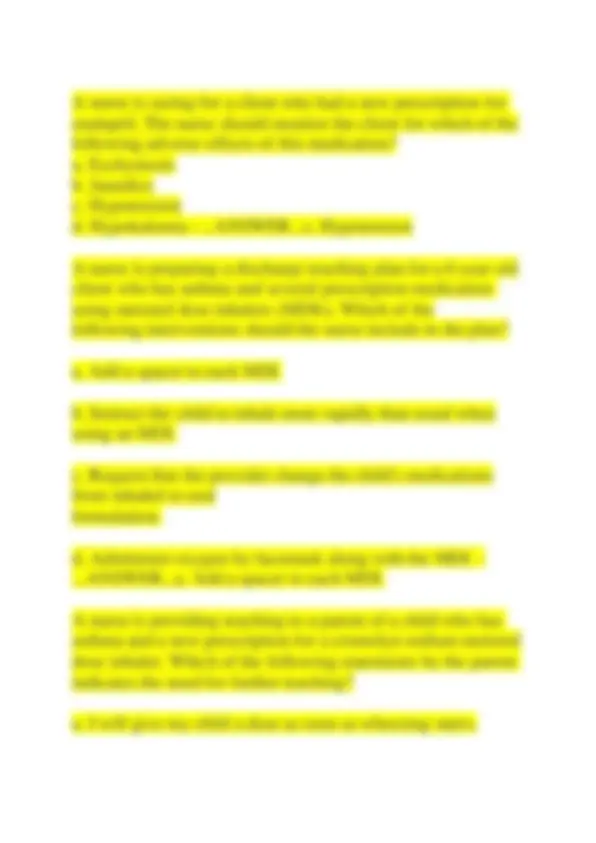
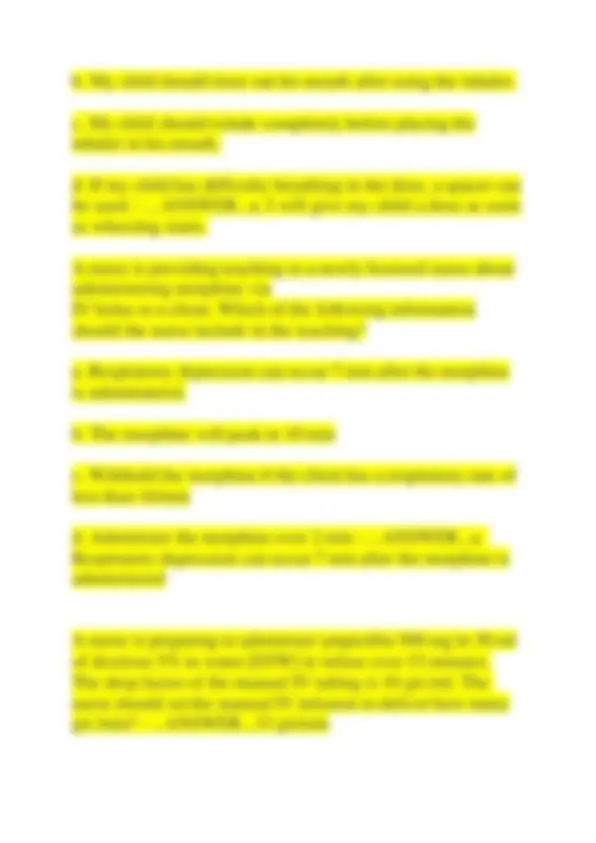
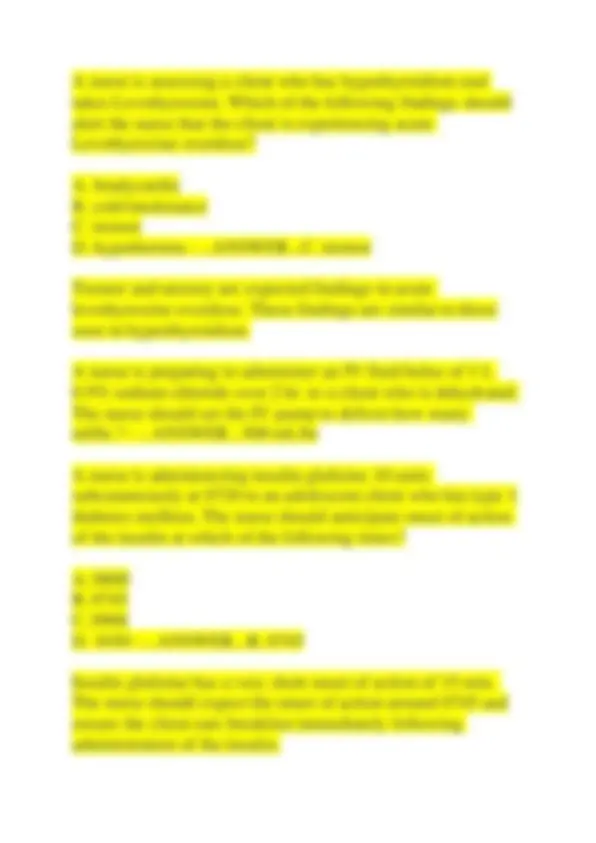
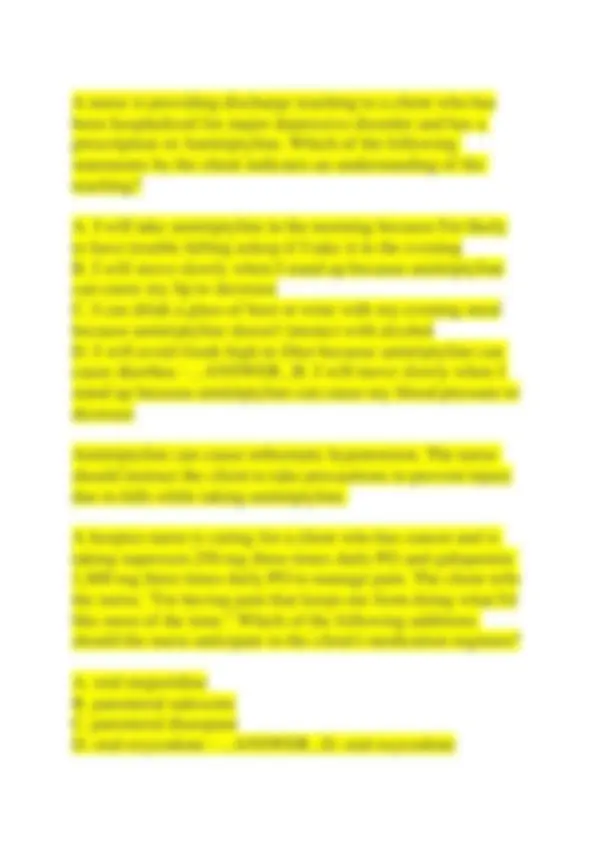
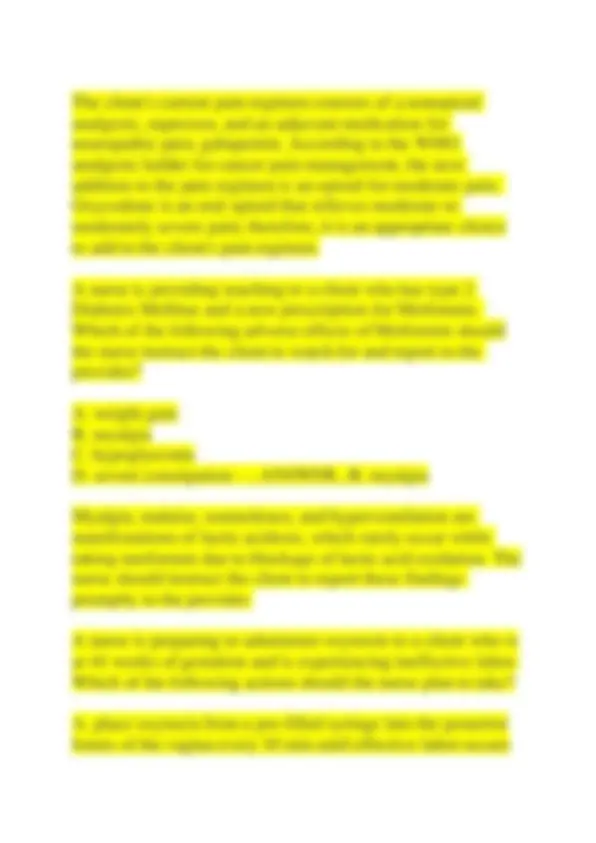
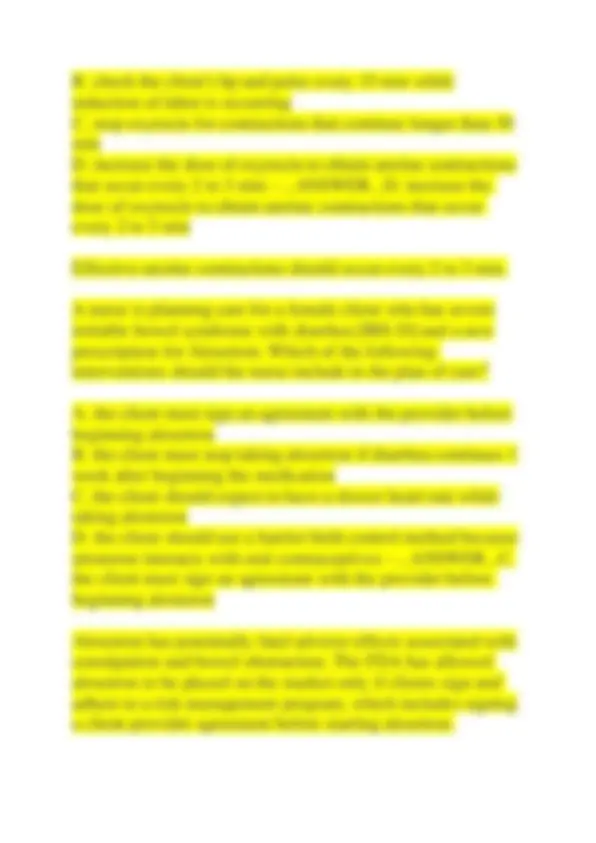
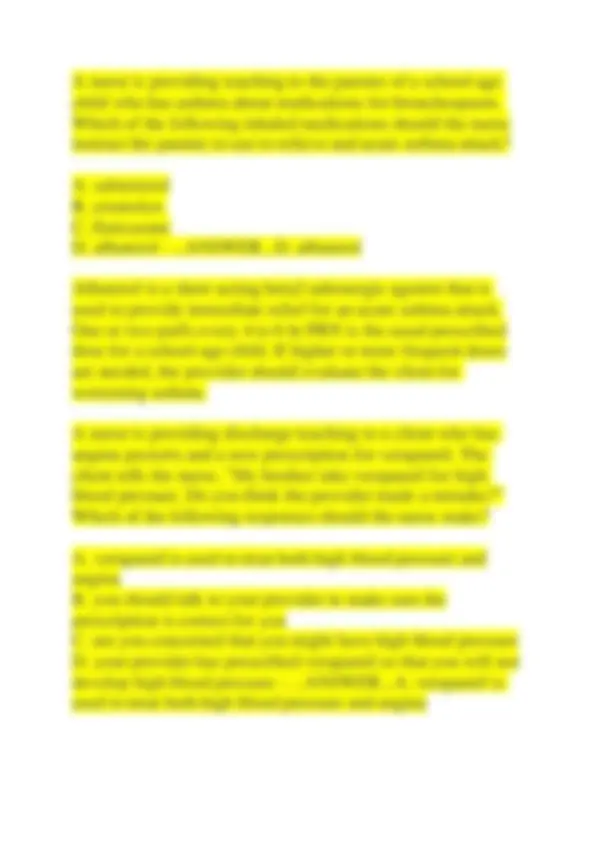
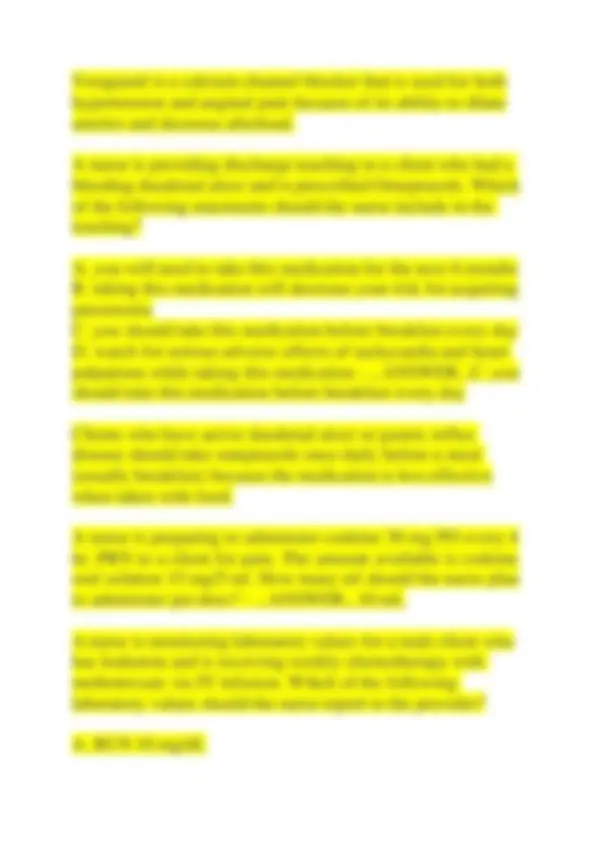
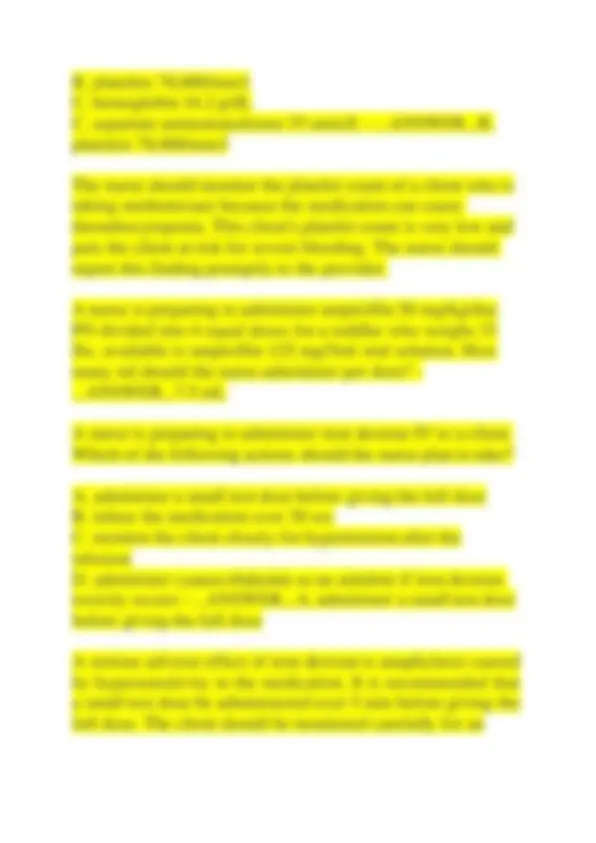
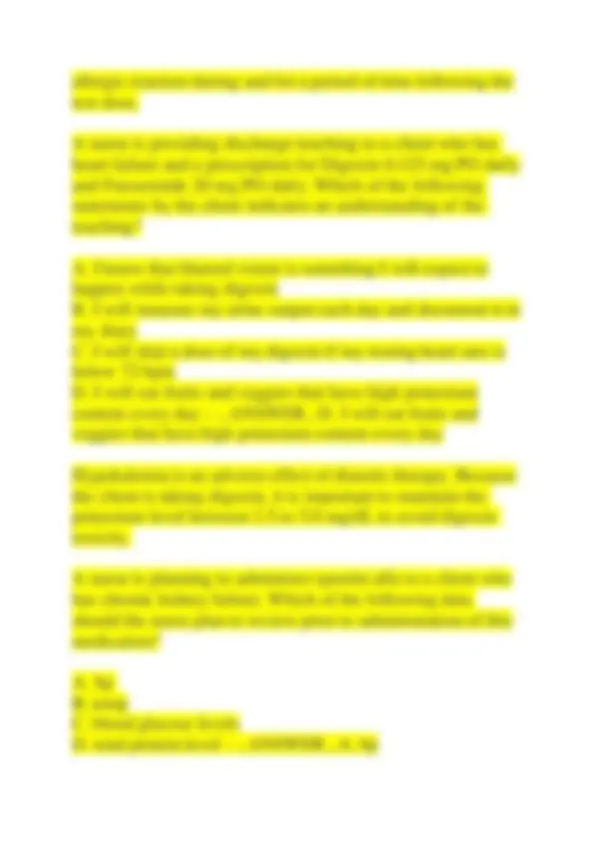
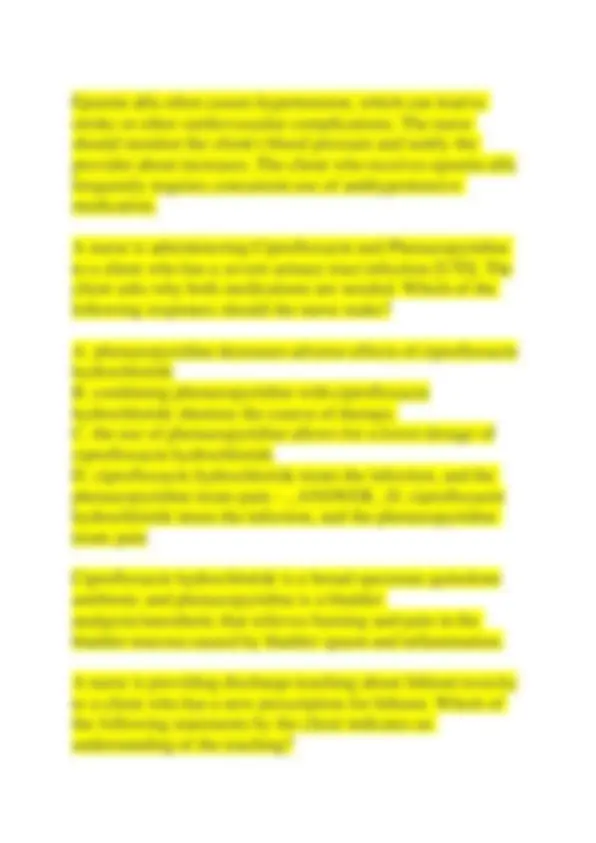
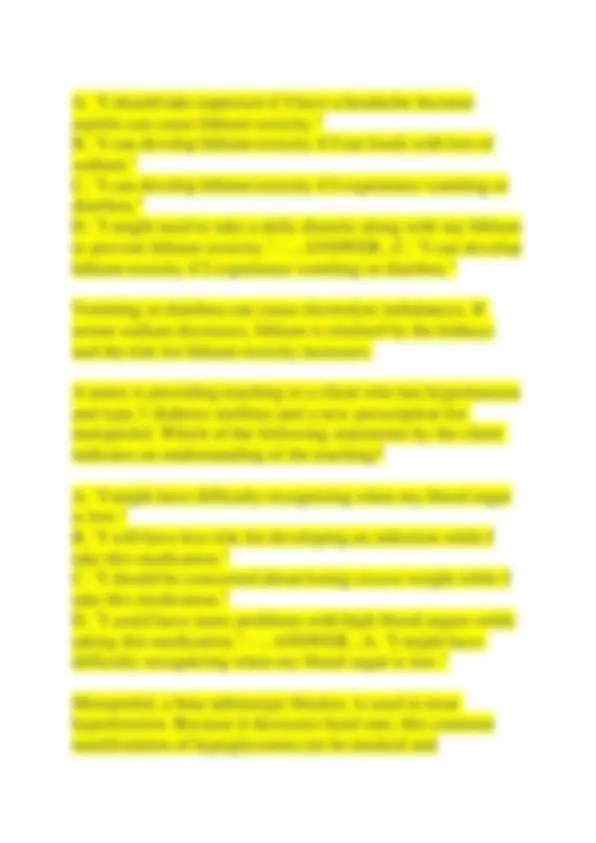
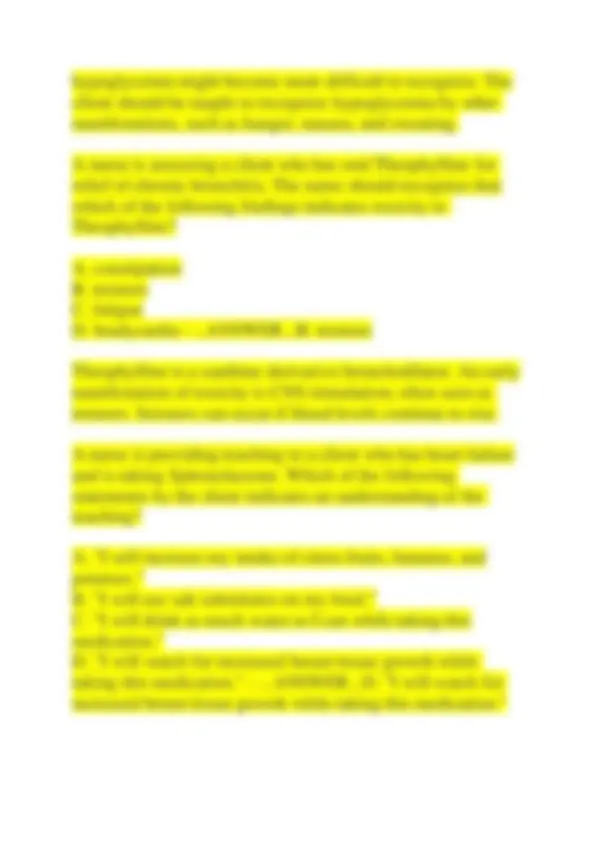
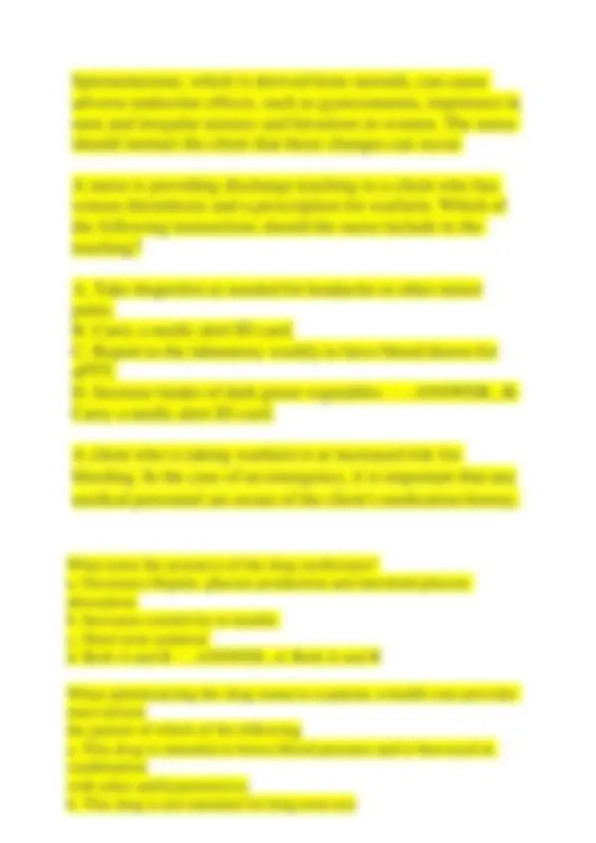

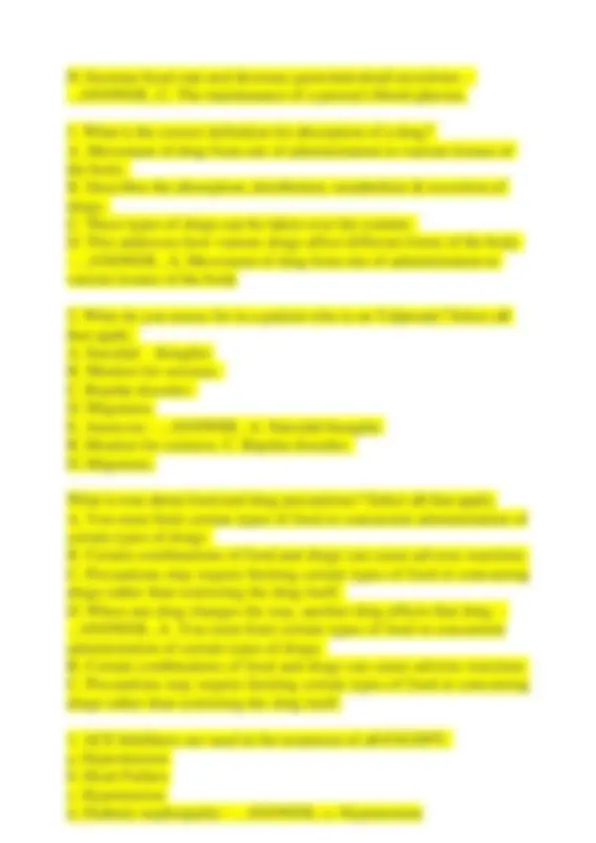
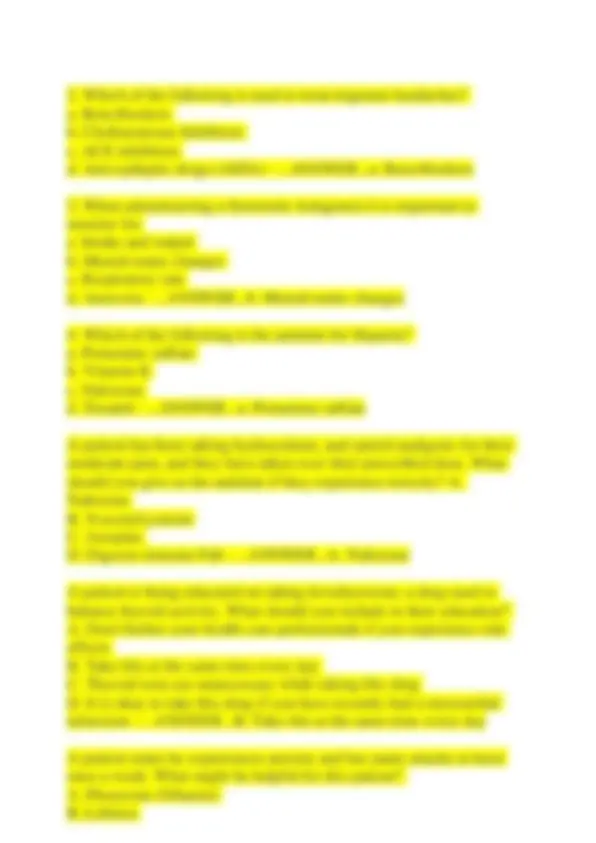
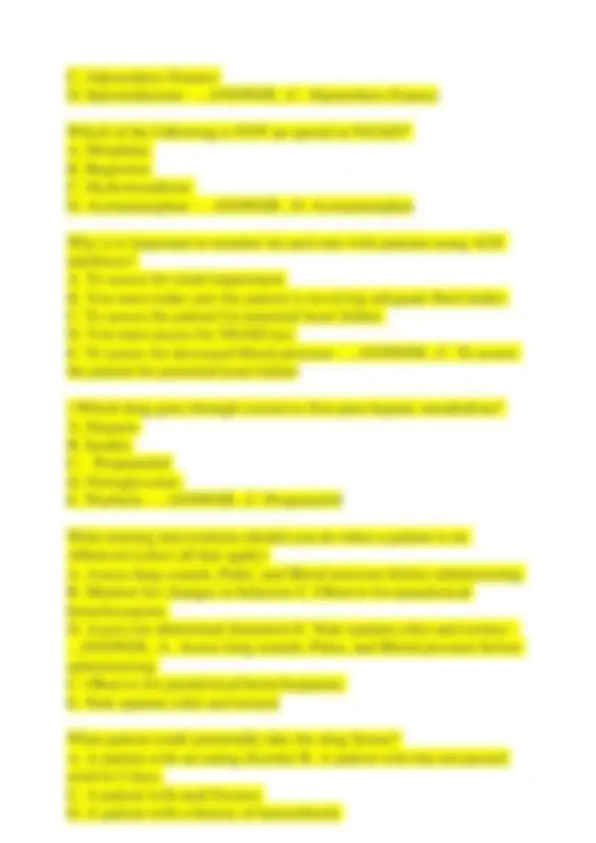
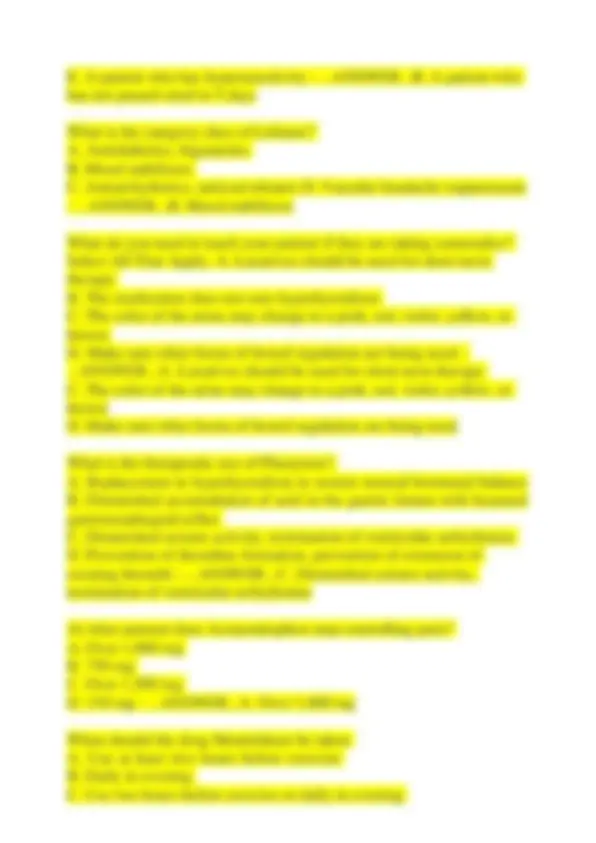
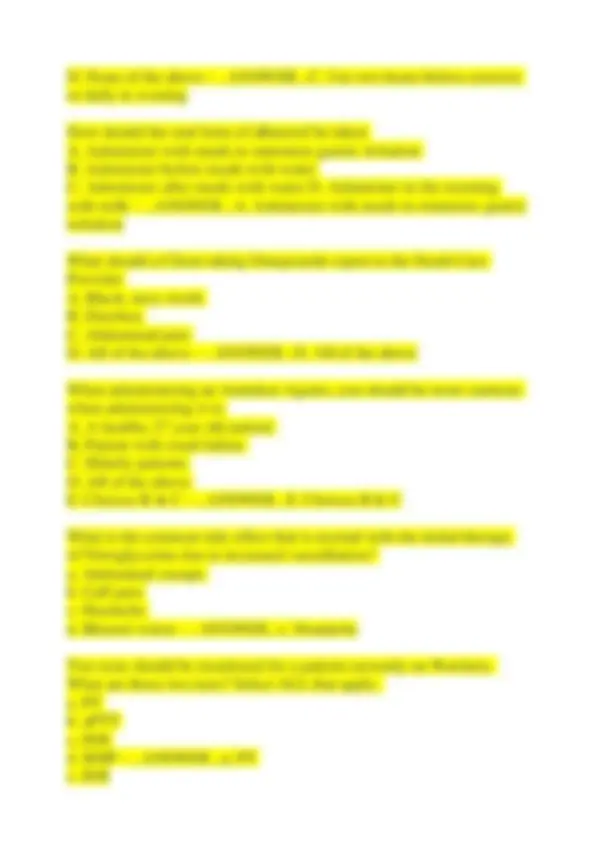
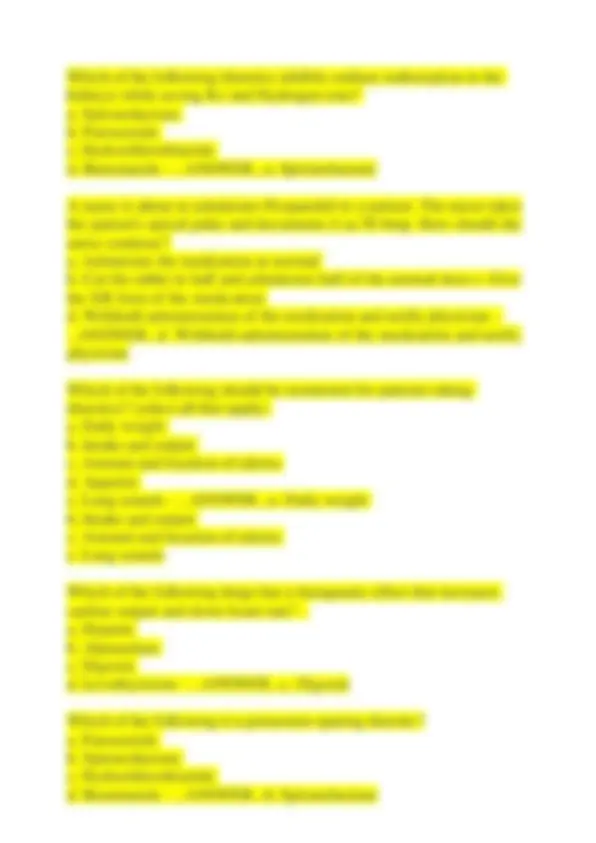

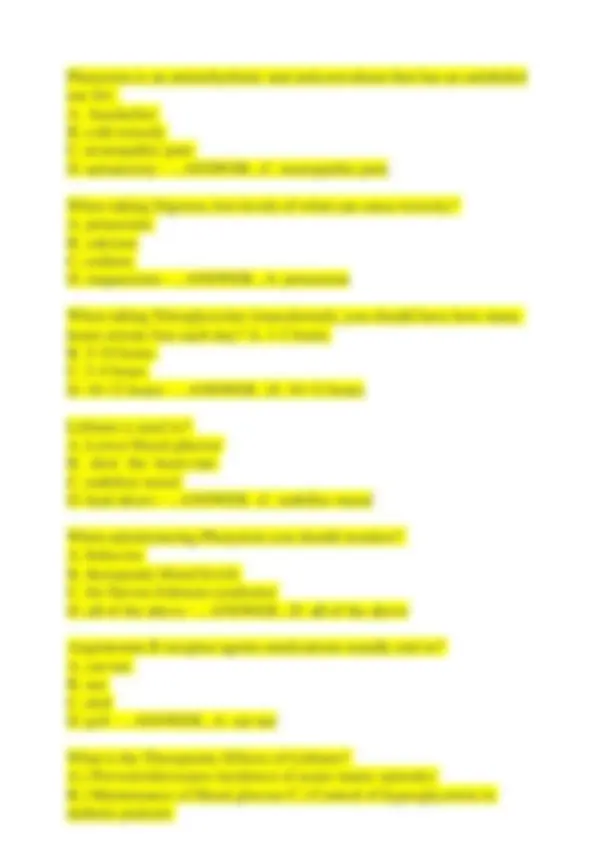
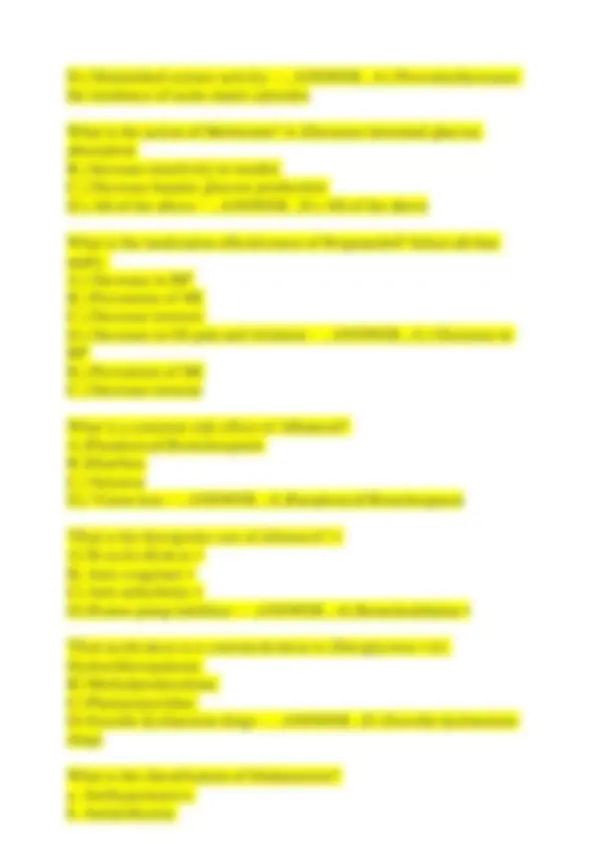
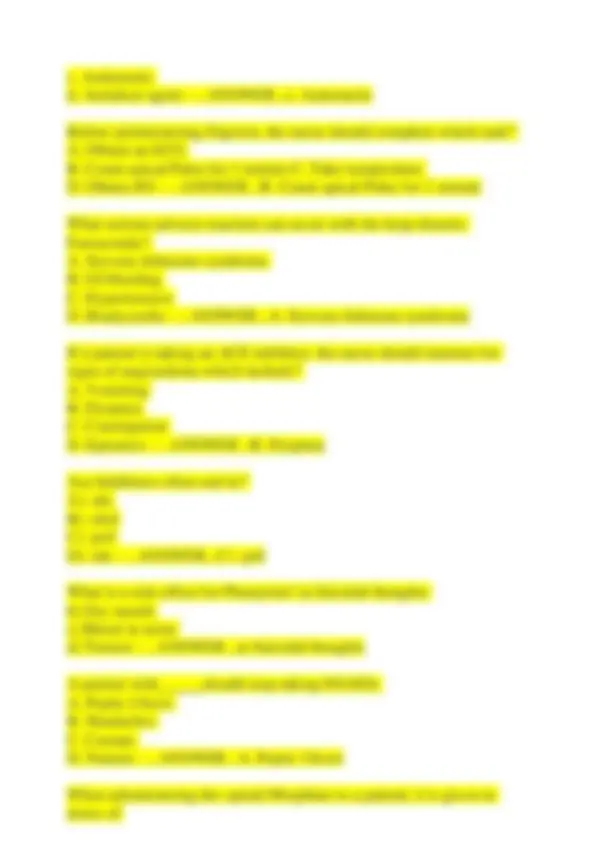
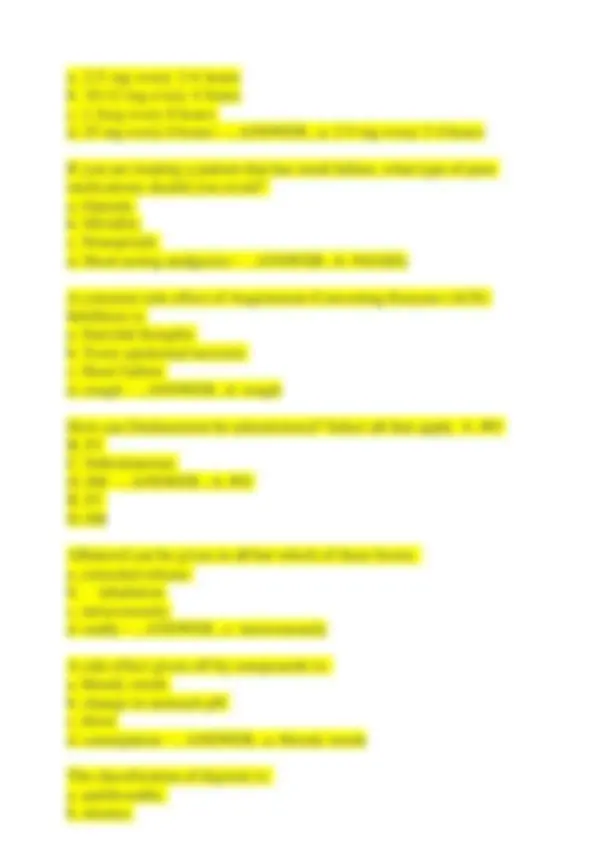
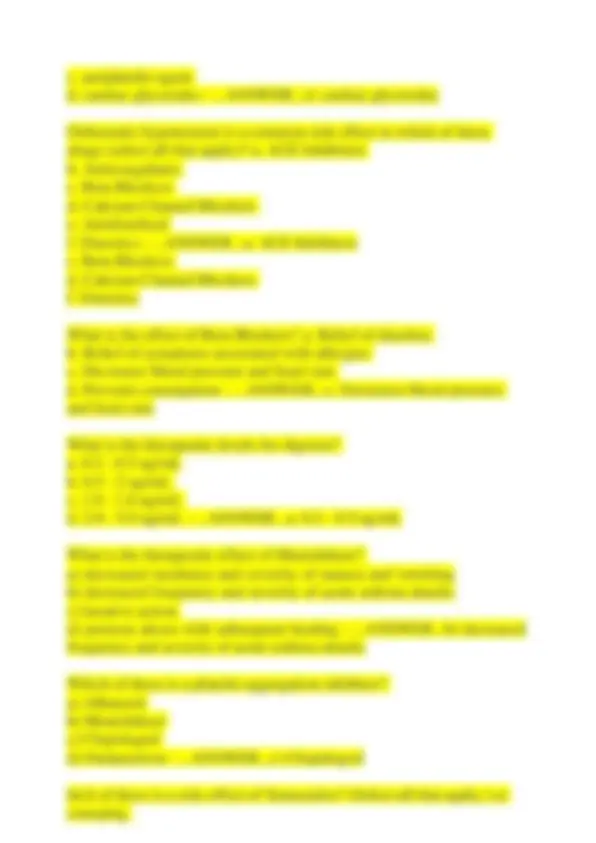
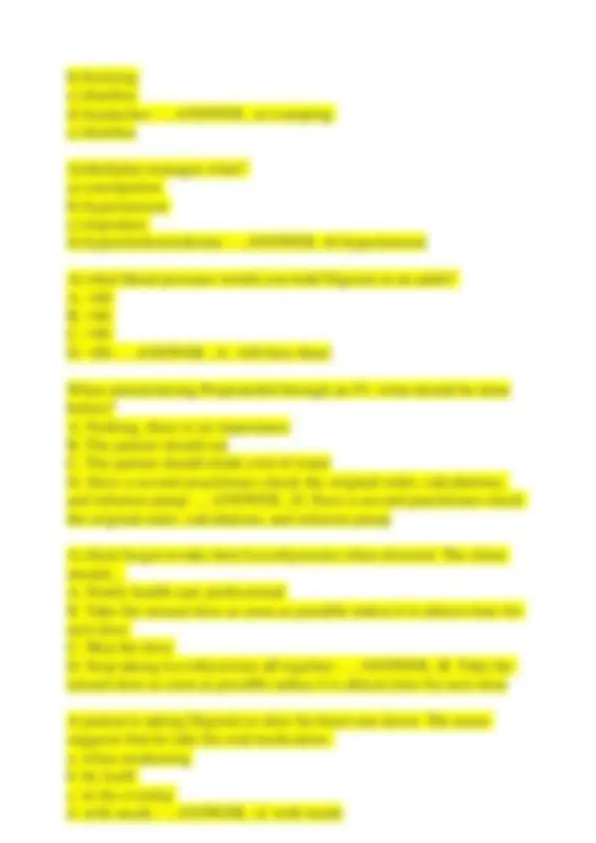


Study with the several resources on Docsity

Earn points by helping other students or get them with a premium plan


Prepare for your exams
Study with the several resources on Docsity

Earn points to download
Earn points by helping other students or get them with a premium plan
Community
Ask the community for help and clear up your study doubts
Discover the best universities in your country according to Docsity users
Free resources
Download our free guides on studying techniques, anxiety management strategies, and thesis advice from Docsity tutors
ATI PHARM PROCTORED 2025 FORM A AND B.pdf
Typology: Exams
1 / 107

This page cannot be seen from the preview
Don't miss anything!





























































































A home health nurse is visiting a client who has heart failure and a prescription for furosemide. The nurse identifies that the client has gained 2.5 kg (5 lb.) since the last visit 2 days ago. Which of the following actions should the nurse take first? a. Encourage the client to dangle the legs while sitting in a chair b. Teach the client about foods low in sodium c. Determine medication adherence by the client d. Notify the provider of the client's weight gain - ....ANSWER...c. Determine medication adherence by the client A nurse is preparing to administer the initial dose of penicillin G IM to a client. The nurse should monitor for which of the following as an indication of an allergic reaction following the injection? a. Urticaria b. Bradycardia c. Pallor d. Dyspepsia - ....ANSWER...a. Urticaria A nurse is teaching a client who has angina a new prescription for sublingual nitroglycerin
tablets. Which of the following instructions should the nurse include in the teaching? a. "Discard any tablets you do not use every 6 months." b. "Take one tablet each morning 30 minutes prior to eating." c. "Keep the tablets at room temperature in their original glass bottle." d. "Place the tablet between your cheek and gum to dissolve."
c. Urine specific gravity 1. d. LDL 120 mg/dL - ....ANSWER...d. LDL 120 mg/dL A nurse is receiving a medication prescription by telephone from a provider. The provider states, "Administer 6 milligrams of morphine IV push every 3 hours as needed for acute pain." How should the nurse transcribe the prescription in the client's medical record? a. Morphine 6 mg IV push every 3 hr PRN acute pain b. MSO 6 mg IV push every 3 hr PRN acute pain c. MS 6 mg IV push every 3 hr PRN acute pain d. Morphine 6.0 mg IV push every 3 hr PRN acute pain - ....ANSWER...a. Morphine 6 mg IV push every 3 hr PRN acute pain A nurse is assessing a client's IV infusion site and notes that the site is cool and edematous. Which of the following actions should the nurse take? a. Show the IV solution rate b. Initiate a new IV distal to the initial site c. Maintain the extremity below the level of the heart d. Apply a warm, moist compress - ....ANSWER...d. Apply a warm, moist compress A nurse is providing teaching to a client who has a new prescription for clozapine. Which of the following statements should the nurse include in the teaching? a. "Diarrhea is a common adverse effect of this medication." b. "Ringing in the ears is an expected adverse effect of this medication." c. "Notify your provider if you develop a fever while taking this medication."
d. "You might experience weight loss while taking this medication." - ....ANSWER...c. "Notify your provider if you develop a fever while taking this medication." A nurse is teaching a client about oral contraceptive. Which of the following information should the nurse include in the teaching? a. Abdominal pain is an expected adverse effect of oral contraceptives b. It can take up to 1 year to become pregnant after stopping an oral contraceptive c. Some herbal supplements can decrease the effectiveness of an oral contraceptive d. A pelvic examination is needed prior to starting an oral contraceptive - ....ANSWER...b. It can take up to 1 year to become pregnant after stopping an oral contraceptive A nurse is planning to administer medication to an older adult client who has dysphagia. Which of the following actions should the nurse plan to take? a. Tilt the client's head back when administering the medications b. Mix the medications with a semisolid food for the client c. Administer more than one pill to the client at a time d. Place the medications on the back of the client's tongue - ....ANSWER...b. Mix the medications with a semisolid food for the client A nurse is providing teaching to a client about the administration of omeprazole. Which of the following should the nurse include? a. "You cannot take this medication with an antacid."
c. Having a prolapsed mitral valve d. Taking an HMG CoA reductase inhibitor - ....ANSWER...a. Taking a high ceiling diuretic A nurse is administering naloxone to a client who has developed an adverse reaction to morphine. The nurse should identify which of the following findings as a therapeutic effect of naloxone? a. Decreased nausea b. Increased pain relief c. Decreased blood pressure d. Increased respiratory rate - ....ANSWER...d. Increased respiratory rate A nurse is reviewing the medical record of a client who has sinusitis and a new prescription for cefuroxime. Which of the following client information is the priority for the nurse to report to the provider? a. The client has a BUN of 18 mg/dL b. The client takes an aspirin daily c. The client has a history of a severe penicillin allergy d. The client reports a history of nausea with cefuroxime - ....ANSWER...c. The client has a history of a severe penicillin allergy A nurse is assessing a client who has hypermagnesemia. Which of the following medications should the nurse prepare to administer? a. Protamine sulfate b. Acetylcysteine c. Calcium gluconate d. Flumazenil - ....ANSWER...c. Calcium gluconate
A nurse is assessing a client following the administration of ondansetron (Zofran). Which of the following findings should indicate to the nurse that the ondansetron has been effective? a. Client reports a decrease in pain b. Client reports a decrease in nausea c. Client reports a decrease in coughing d. Client reports a decrease in diarrhea - ....ANSWER...b. Client reports a decrease in nausea A nurse manager is planning an in-service about pain management with opioids for client who has cancer. Which of the following information should the nurse manager include? a. IM administration is recommended if PO opioids are ineffective b. Respiratory depression decreases as opioid tolerance develops c. Meperidine is the opioid of choice for treating chronic pain d. Withhold PRN pain medication for the client who is receiving opioids every 6 hr - ....ANSWER...a. IM administration is recommended if PO opioids are ineffective A nurse is reviewing the list of current medication for a client who is to start prescription for carbamazepine. The nurse should identify that which of the following medications interacts with carbamazepine? a. Nicotine transdermal system b. Diphenhydramine c. Estrogen-progestin combination (Non-hormonal forms of contraception) d. Beclomethasone - ....ANSWER...c. Estrogen-progestin combination (Non-hormonal forms of contraception)
a. "You will need liver function tests before beginning therapy." b. "Avoid consuming dairy products while taking this medication." c. "You may crush the medication and mix it with applesauce." d. "You should take the medication in the morning." - ....ANSWER...a. "You will need liver function tests before beginning therapy." A nurse is assessing a client who is receiving a peripheral IV infusion and notes infiltration of fluid into the tissue surrounding the insertion site. Which of the following actions should the nurse take? a. Flush the IV catheter b. Apply pressure to the IV site c. Elevate the extremity d. Slow the infusion rate - ....ANSWER...c. Elevate the extremity A nurse is preparing to administer 4,000 units of heparin subcutaneously to a client who has deep-vein thrombosis. Available is heparin 10,000 units. How many mL of heparin should the nurse administer? (Round to the nearest tenth. Use a leading zero if it applies. Do not use a trailing zero.) a. 0.4 mL - ....ANSWER...a. 0.4 mL A nurse is caring for a client who is in shock and is receiving an infusion of albumin. Which of the following findings should the nurse expect? a. Oxygen saturation 96% b. PaCO2 30 mm Hg
c. Increase in BP d. Decrease in protein - ....ANSWER...c. Increase in BP A nurse is discussing adverse reactions to pain medications in older adult clients with a newly licensed nurse. Which of the following findings should the nurse include as risk factors for an adverse drug reaction? (SATA) a. Polypharmacy b. Increased rate of absorption c. Decreased percentage of body fat d. Multiple health problems e. Decreased renal function - ....ANSWER...a. Polypharmacy c. Decreased percentage of body fat d. Multiple health problems e. Decreased renal function A nurse is reviewing the laboratory data of a client prior to administering IV tobramycin. Which of the following laboratory values should the nurse report to the provider? a. Sodium 137 mEq/L b. Hct 4.3% c. Hgb 15 g/dL d. Creatinine 2.5 mg/dL - ....ANSWER...d. Creatinine 2. mg/dL A nurse is preparing to administer enoxaparin to a client. Which of the following actions should the nurse take? a. Apply firm pressure to the injection site following administration b. Administer the medication into the client's muscle c. Expel the air bubble from the syringe prior to injection
min." which of the following reasons should the nurse clarify this prescription with the provider. a. Potassium chloride should be diluted in dextrose 5% in water. b. The potassium infusion rate is too rapid c. Another formulation of potassium should be given IV d. The client should be treated by giving potassium by IV bolus - ....ANSWER...b. The potassium infusion rate is too rapid A nurse is monitoring laboratory values for a client who has chronic heart failure and is receiving digoxin. Which of the following values should the nurse report to the provider? a. Sodium 1.38 mEq/dL b. Magnesium 1.5 mEq/L c. BUN level 10 mg/dL d. Potassium 2.9 mEq/L - ....ANSWER...d. Potassium 2. mEq/L A client who has active tuberculosis and is taking rifampin reports that his urine and sweat have developed a red tinge. Which of the following actions should the nurse take? a. Check the client's liver function test results b. Instruct the client to increase his fluid intake c. Document this as an expected finding d. Prepare the client for dialysis - ....ANSWER...c. Document this as an expected finding A nurse accidently administers the medication metformin instead of metoprolol to a client. Which of the following actions should the nurse take? a. Monitor the client's thyroid function levels b. Collect the client's uric acid level
c. Obtain the client's HDL level d. Check the client's glucose level - ....ANSWER...d. Check the client's glucose level A nurse is administering 4 mg of hydromorphone to a client by mouth every 4 hr. the medication is provided as hydromorphone 8 mg per tablets. Which of the following actions is appropriate for the nurse to take? a. Return the remaining medication to the facility's pharmacy b. Store the remaining half of the pill in the automated medication dispensing system c. Place the remaining half of the pill in the unit dose package d. Dispose of the remaining medication while another nurse observes - ....ANSWER...d. Dispose of the remaining medication while another nurse observes A nurse is caring for 4 - year-old child following an orthopedic procedure. When assessing the child for pain. Which of the following pain scales should the nurse use? a. FACES b. Numeric c. CRIES d. Word graphic - ....ANSWER...a. FACES A nurse is planning care for a client who requires treatment for high cholesterol. Which of the following prescriptions should the nurse expect to administer? a. Colchicine b. Cimetidine c. Colerain - Colesevelam (Welchol) d. Chlorpromazine - ....ANSWER...c. Colerain - Colesevelam (Welchol)
whole number. Use a leading zero if it applies. Do not use a trailing zero.) a. 325 mcg - ....ANSWER...a. 325 mcg A nurse is preparing to initiate IV therapy for a client. Which of the following sites should the nurse use to place the peripheral IV catheter? a. Nondominant dorsal venous arch b. Dominant distal dorsal vein c. Nondominant forearm basilic vein d. Dominant antecubital vein - ....ANSWER...a. Nondominant dorsal venous arch A nurse is assessing a client who is taking an osmotic laxative which of the following findings should the nurse identify as an indication of fluid volume deficit? a. Nausea b. Weight gain c. Headache d. Oliguria - ....ANSWER...d. Oliguria A nurse is reviewing the laboratory results of a client who is taking amitriptyline which of the following laboratory values should the nurse report to the provider? a. Total bilirubin 1.5 mg/dL b. Potassium 4.2 mEq/L c. Hct 0.44% d. WBC count 5,000/mm3 - ....ANSWER...a. Total bilirubin 1.5 mg/dL A nurse is caring for a client who is taking lithium and reports starting a new exercise program. The nurse should assess the client for which of the following electrolyte imbalances?
a. Hypocalcemia b. Hypokalemia c. Hyponatremia d. Hypomagnesemia - ....ANSWER...c. Hyponatremia A nurse is assessing a client after administering phenytoin IV bolus for a seizure. Which of the following should the nurse identify as an adverse effect of this medication? a. Hypoglycemia b. Bradycardia c. Red man syndrome d. Hypotension - ....ANSWER...b. Bradycardia A nurse is consulting a formulary about a client's new prescription for raloxifene. The nurse should identify that this medication is used to treat which of the following conditions? a. Osteoporosis b. Hypothyroidism c. Urinary tract infection d. Deep vein thrombosis - ....ANSWER...a. Osteoporosis A nurse is providing discharge dietary teaching to a client who has a something and is taking medication theophylline and to provide general instructions the nurse should include? Avoid caffeinated beverages Take the medication with meals Restrict milk products Limit sodium intake - ....ANSWER...Avoid caffeinated beverages A nurse is mixing regular insulin and NPH into a syringe for a client who has diabetes mellitus. Which of the following actions should the nurse take first?
c. Digibind d. Fluemanzil - ....ANSWER...c. Digibind While providing an Angiotensin-converting enzyme (ACE) inhibitor, the patient asks what the action of the drug is. As a health care provider, you explain that the action of an ACE inhibitor is a. To lower blood pressure by blocking the conversion of angiotensin I to vasoconstrictor angiotensin II b. To inhibit reabsorption of sodium back into the body, ultimately increasing urine output and lowering blood pressure c. To decrease heart rate and blood pressure by competing with Beta1 and Beta receptors in the heart and lungs d. To lower blood glucose by stimulating the release of insulin
D. Increase heart rate and decrease gastrointestinal secretions.